The EASIEST NAS Software You Can Use on Your Custom NAS Server
The appeal of building your very own NAS server instead of purchasing pre-built and OS-locked alternatives from brands like Synology or QNAP, as well as ditching third-party cloud storage from Google and Apple that is subscription-based, cannot really be argued with! The savings that can be made in terms of cost, and the flexibility and customization afforded to a build-your-own/do-it-yourself solution, aren’t really up for debate. However, one thing that is debatable is just how easy the majority of open-source and hardware-free NAS software actually is! There are numerous kinds of NAS software in the market that you can choose to install on second-hand, defunct hardware and highly optimized hand-built server solutions, but despite the improved simplicity of computer building in the last decade, NAS software still continues to be surprisingly complicated, and once you break into the world of business storage, it becomes damn near inscrutable to the outsider. So today, I want to discuss five great examples of genuinely user-friendly network-attached storage software that you can install on your custom server hardware today! Some are more user-friendly than others, some are more feature-rich than others, and some split support and assistance into different tiers of access when you need it. Ultimately, these represent arguably five of the best options you have in 2024 to install software on your NAS, regardless of your level of knowledge in networking and data storage.
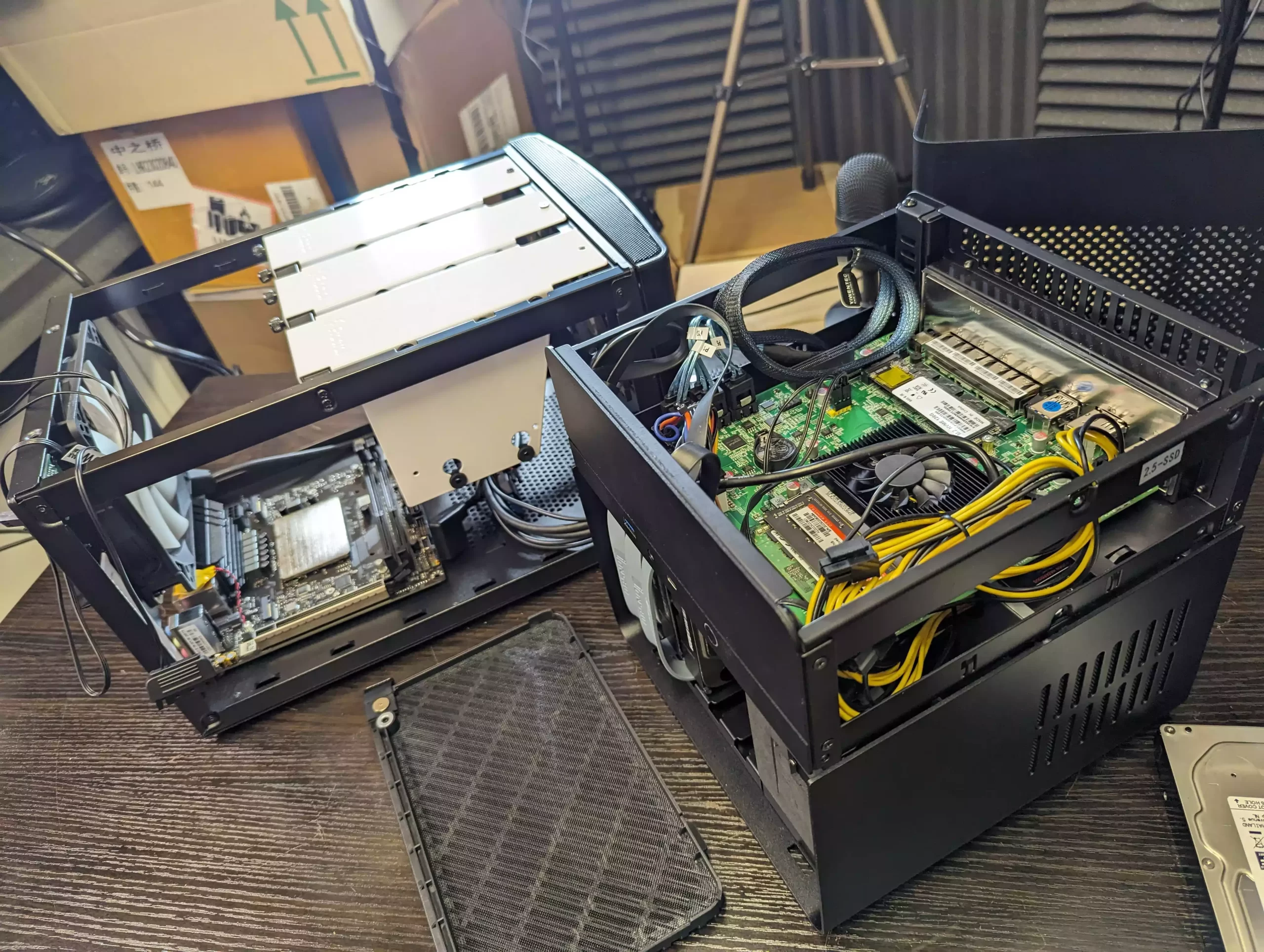
CasaOS and ZimaOS – Easy and Lite!
Price: FREE – Features 5/10 – Ease of Use 9/10 – Release May 2015 – DOWNLOAD

Arguably the second-youngest operating system mentioned in this article, Casa OS and the later, more storage-optimized Zima OS are operating systems developed by the company IceWhale. Both of them are tremendously lightweight operating systems designed to run on x86 hardware-built servers (such as Intel Celeron, Pentium, Core, Xeon, etc.) with at least 2 GB of memory to be fully utilized. Arriving with a client application for your desktop and accessible via the web browser, both can be set up and accessed within minutes of installation. There is an extremely user-friendly desktop GUI, and although the settings and configuration options feel quite limited compared with other entries on this list, if you are looking for simplicity and clarity in the way your system configuration is presented, Casa OS and Zima OS really cannot be beaten.
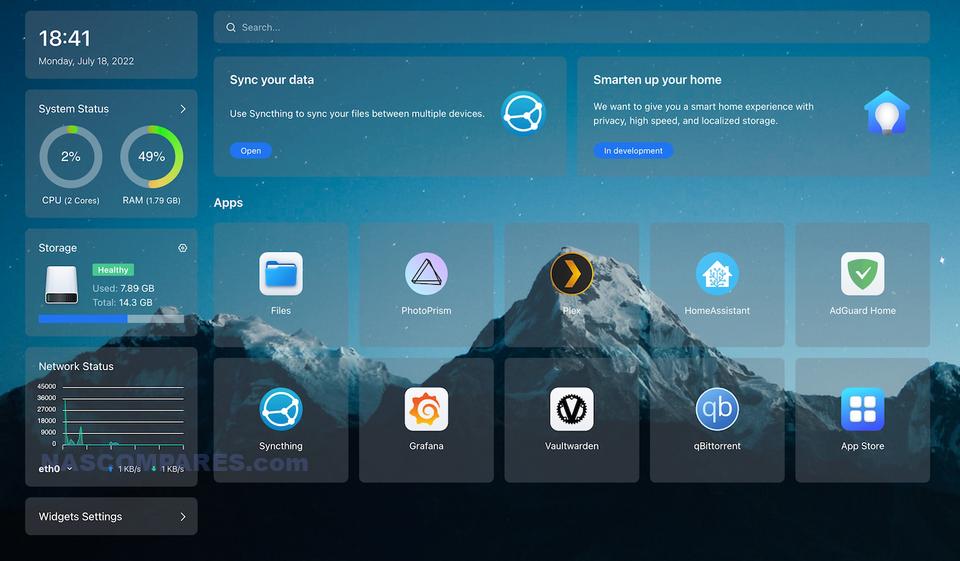

However, it’s worth remembering that this simplicity in how the information is being presented to you does echo right down to the feature set of the operating system on your server. For example, Casa OS does not (at least as of early 2024) feature any kind of RAID support across multiple drives, and RAID integration into Zima OS is still barely a few months old—a base level introduction feature in the majority of other NAS software. Equally, although file and folder level access to your data is available via a native browser application, which also includes mounting cloud spaces for synchronization, practically every other app and service you install is done so via a container repository. This in itself isn’t really a bad thing, as they still managed to make the installation one-click, but it does mean that beyond the initial OS and some arguably rather rudimentary features, the more advanced and feature-rich experience is going to involve the installation of a whole lot of third-party applications via the simplified container system.
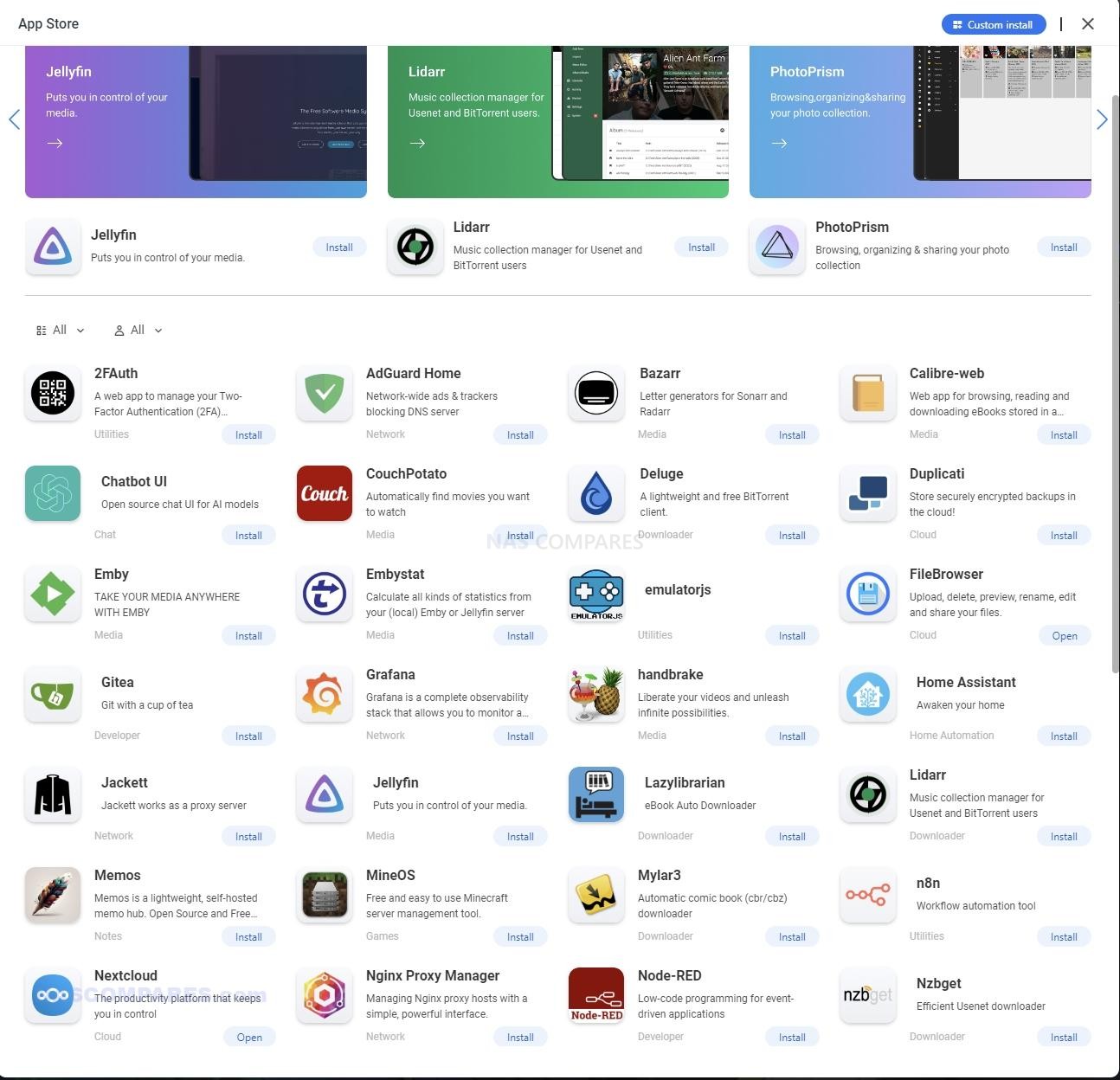
Casa OS and Zima OS are among the very few applications available in the NAS server market that are completely free, with no real pricing or subscription models that are going to get in the way of running your server on this software. Yet, despite this lack of an overt pricing model, feature and security updates are actually pretty regular. The fact that they have rolled out the more advanced Zima OS in line with their currently crowdfunded system shows IceWhale’s dedication towards this NAS OS. It is a very responsive and low-resource-consuming NAS operating system, with a very low learning curve for its introduction. But just keep in mind that what it gains in its simplicity and smooth UX, it loses in terms of a more feature-rich experience.
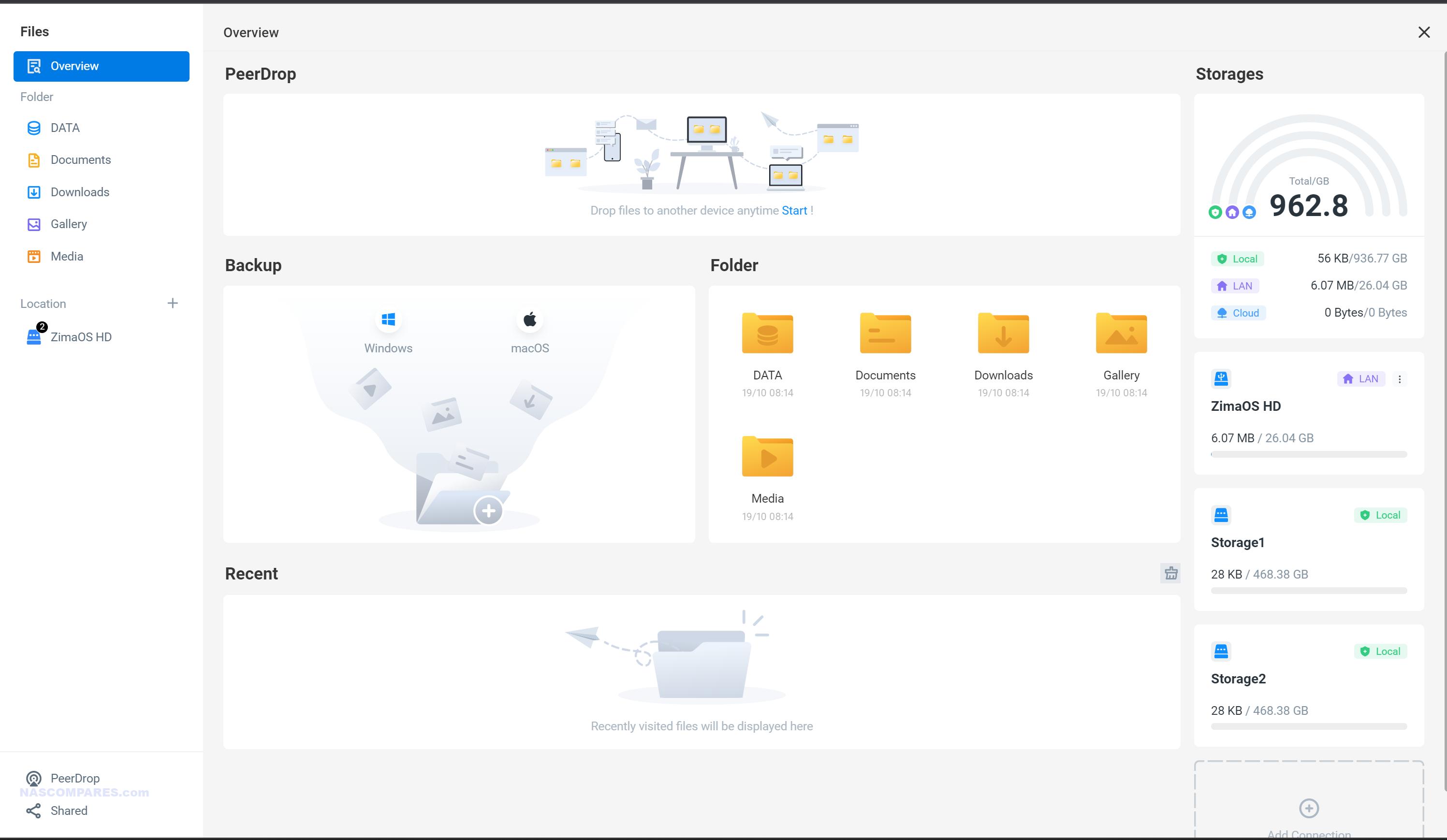
UnRAID – Easy AND Capable, YES PLEASE!
Price: 30 Day Trial, then $49/109/249 (Based on Scale/Time) – Features 10/10 – Ease of Use 8/10 – Release May 2005 – DOWNLOAD

If you have looked at any forum post, any community support forum, or any server-based education platform and asked the question, “What is the most user-friendly NAS software in the market?”, 90% of the time you will hear users say UnRAID. Everything about UnRAID seemingly focuses on efficiency and ease of use, right down to how you install the software on your custom server. Unlike a lot of other NAS software in the market that requires you to provide a completely separate SSD for the installation of the operating system, UnRAID circumnavigates this by running almost entirely on the RAM. UnRAID is installed by preparing a USB via a fantastically user-friendly client app on another computer, completely for free and created inside 10 minutes. A simple 8GB USB for a couple of bucks will be more than enough. Then you take that USB and stick it inside your newly built NAS server or second-hand old hardware you’re going to repurpose, boot the system from the USB drive, and that is it. UnRAID will deploy itself from the USB and onto the system memory. After that, you can access UnRAID via the web browser like any other server, and have access to some fantastically diverse parity and storage pool options, as well as access to one of the largest libraries of one-click containerized applications available in the market.
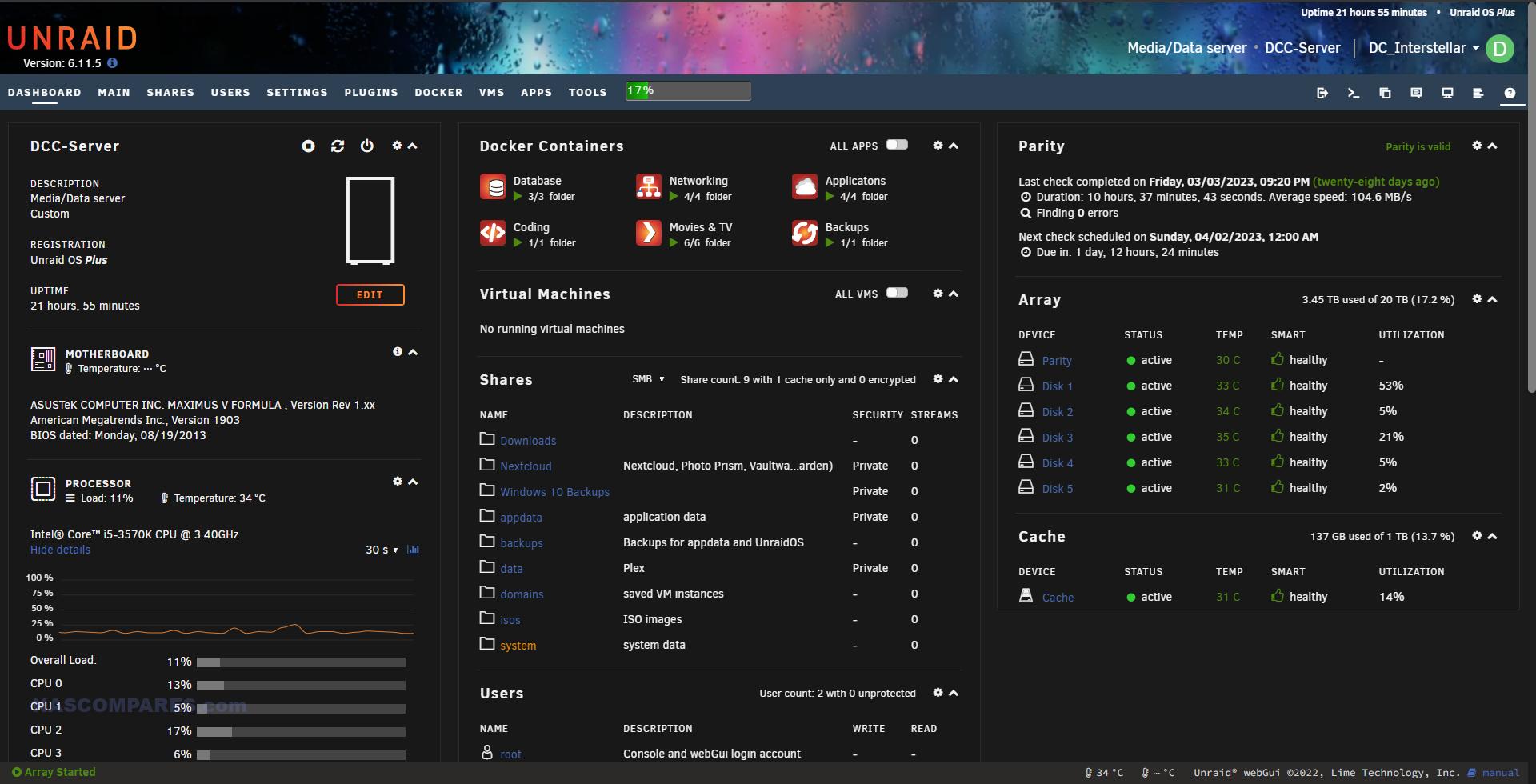
UnRAID manages to integrate numerous desirable features currently available in different NAS software in the market, but unifies them into this single software operating system. Do you want the mixed storage media advantages present in Synology DSM and Synology Hybrid RAID? No problem, UnRAID supports mixed drive deployment. Do you want the performance benefits and background stability options of Zettabyte File System but find it scarily technical? No trouble, you can mount and use ZFS storage pools in UnRAID easily and quickly. Do you want a single portal user interface that tells you the CPU, memory, user, network, process load, and everything else in a single screen, giving you everything you need to know about your system at once, as found in enterprise-grade SAN/server software? No trouble, UnRAID has this on its very first screen!
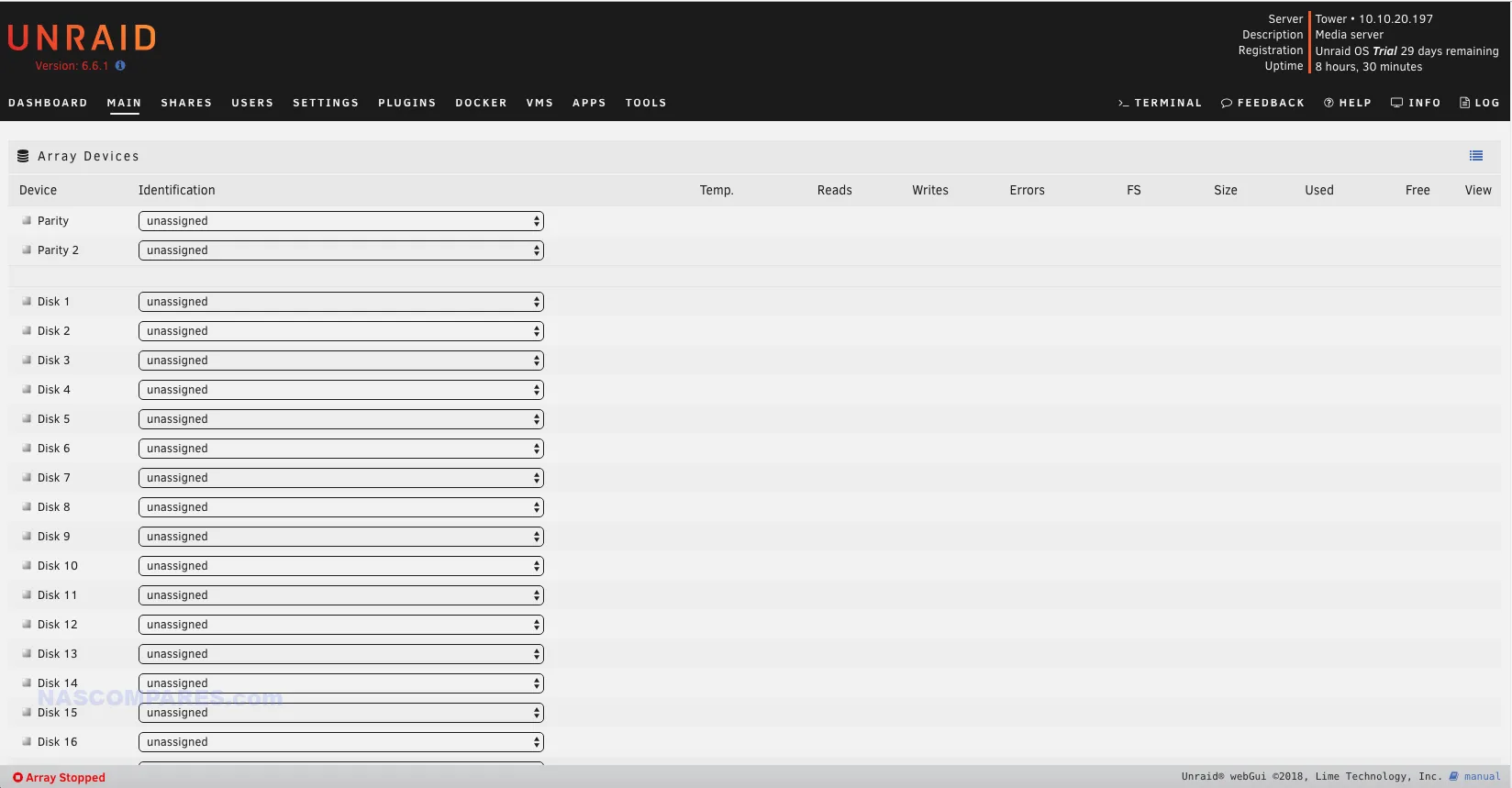
As good as all this sounds, it is important to keep your feet on the ground and know that UnRAID is by no means a perfect software platform for your NAS. For a start, although the bulk of options and server configuration/maintenance are quite intuitive and the UX has everything where you expect it to be, the initialization of your storage at the beginning is far less straightforward and the storage manager is long overdue for some kind of easy setup wizard, which is present in the majority of other NAS OS. It’s a real shame because in practically every other regard, UnRAID keeps things incredibly straightforward. Although it provides significant options to access the command line and terminal, it does not rely on these, and a lot of users can get around using UnRAID and never have to use any kind of command line beyond advanced processes and in-depth troubleshooting. Equally, there are going to be users who may balk at the idea of a subscription payment-based model.
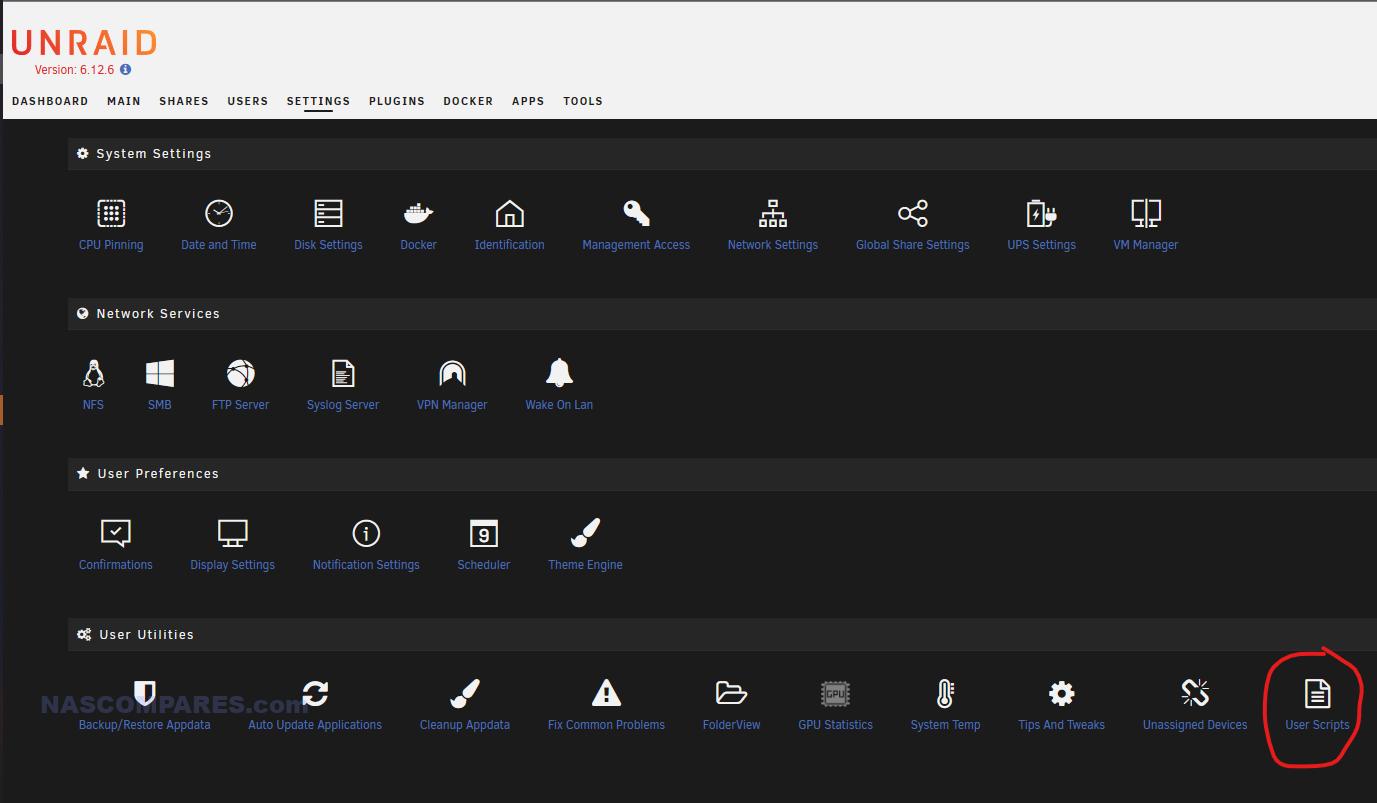
UnRAID arrives with a 30-day free trial, which given the ease of installation with a simple USB key that runs out of the RAM, isn’t too shabby. After that, subscription prices range from annual prices based on the size of your array to lifetime memberships that cost around $250. It is worth keeping in perspective that UnRAID is a lifetime OS that allows for adding infinite drives to your array, as well as moving from one hardware configuration system to the next with ease—fantastic scalability. Also, UnRAID provides services to access your server remotely and safely, and the subscription model allows for regular security and feature updates throughout the course of your usage of the software.
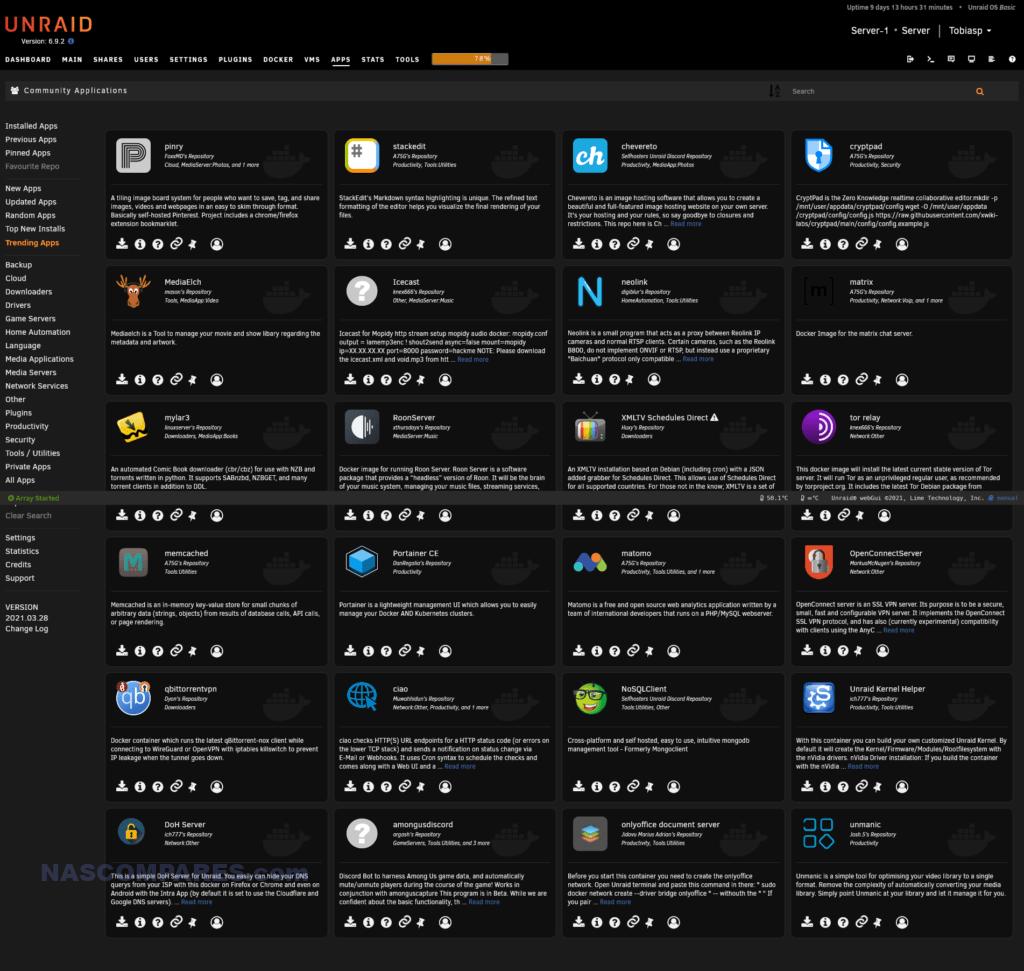
Bottom line, there is a good reason why UnRAID is still regarded as the most user-friendly yet capable NAS operating system in the market. To date, it is feature-rich, balances business features and home features, and provides the toolset to do more with it, while still maintaining high levels of usability in its base-level functions for the newbie.
OpenMediaVault (OMV) – An Oldie but a Goodie!
Price: FREE – Features 8/10 – Ease of Use 7/10 – Release May 2011 – DOWNLOAD

OpenMediaVault (OMV) is a flexible and open-source NAS (Network-Attached Storage) software designed to help users efficiently manage and store data on custom or DIY NAS systems. One of the key advantages of OMV is that it is completely free, which makes it an attractive option for users who want to avoid the costs associated with other commercial NAS solutions. OMV offers a variety of useful features, including support for multiple storage options, allowing users to set up configurations that meet their needs for data protection and performance. It also includes network services for sharing files across different devices and users, making it convenient for both home and small business environments. Furthermore, OMV supports a range of plugins that enhance its functionality, enabling users to easily add services such as media streaming, cloud integration, and backup solutions. While it might not be as graphically appealing as some other NAS software, its straightforward and functional design ensures it gets the job done effectively.
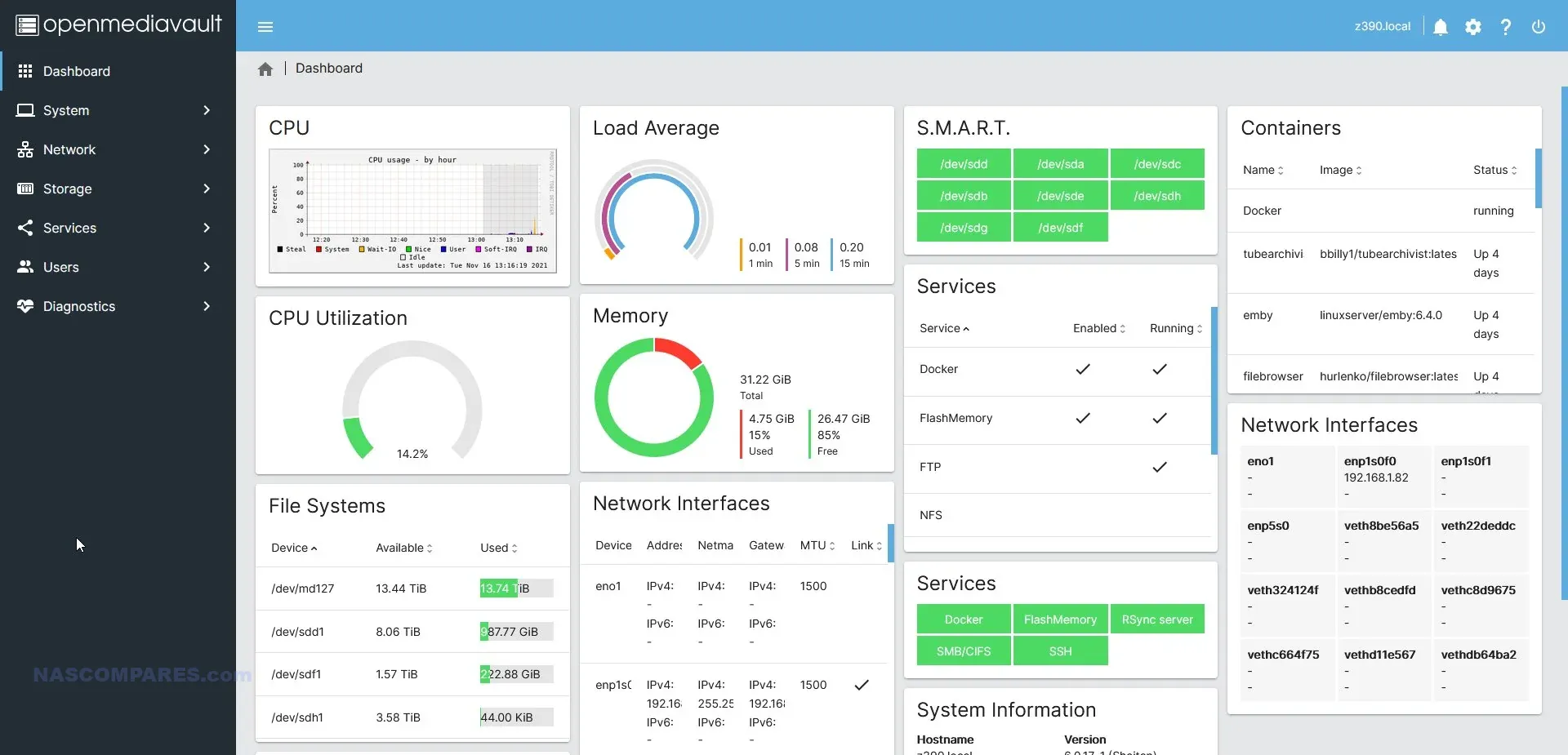
OpenMediaVault is generally considered to be user-friendly, especially for individuals who are new to setting up NAS systems. Despite its somewhat less polished appearance compared to some commercial alternatives, OMV provides a practical and straightforward interface. The installation process, however, can be a bit messy and might require more steps than some users expect. Unlike some other NAS software that offers a streamlined installation from a single USB stick, OMV’s setup may involve creating a bootable drive and configuring the system manually, which can be a bit cumbersome for beginners. Once installed, OMV’s interface is accessible through a web browser, offering a clear and organized layout that simplifies the management of storage, user accounts, and various services. This makes it easy for users to navigate and adjust settings as needed. Although setting up storage options and configuring network services might require a bit of learning for those new to NAS, OMV provides extensive documentation and community support to help users through the process.
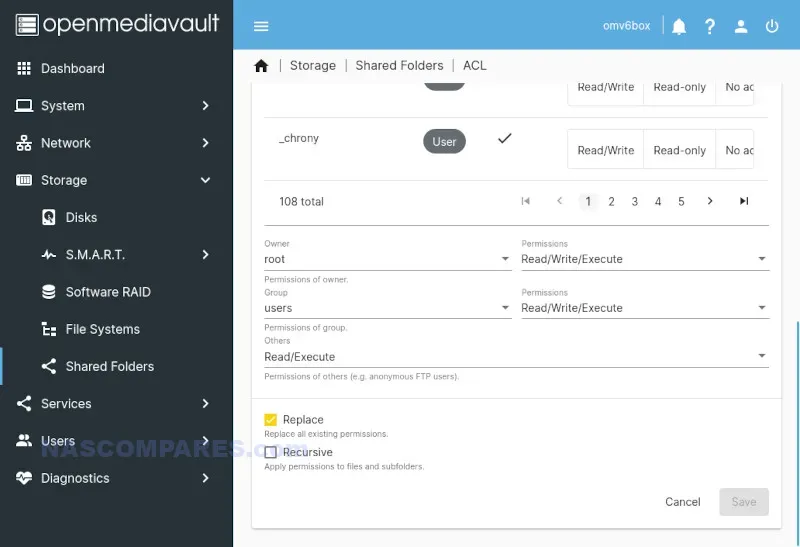
When comparing OpenMediaVault to UnRAID, several differences become evident. UnRAID is often highlighted for its ease of use and straightforward setup, which typically involves a quick installation process using a USB stick, making it very accessible for those new to NAS systems. UnRAID’s approach allows for flexible use of different types and sizes of storage drives without needing complex configurations, which is particularly appealing for users who want to mix and match their storage options. OpenMediaVault, while also user-friendly, offers a more traditional approach to storage setups and a broader range of network services and plugins, which may appeal to users looking for more control and customization. Although OMV might require a bit more effort to fully understand and set up, and its graphical interface may not be as modern or visually appealing as that of UnRAID, it provides a strong balance of simplicity and advanced features. This makes it a robust choice for a wide range of users who are interested in building their own NAS systems without incurring additional costs for software.
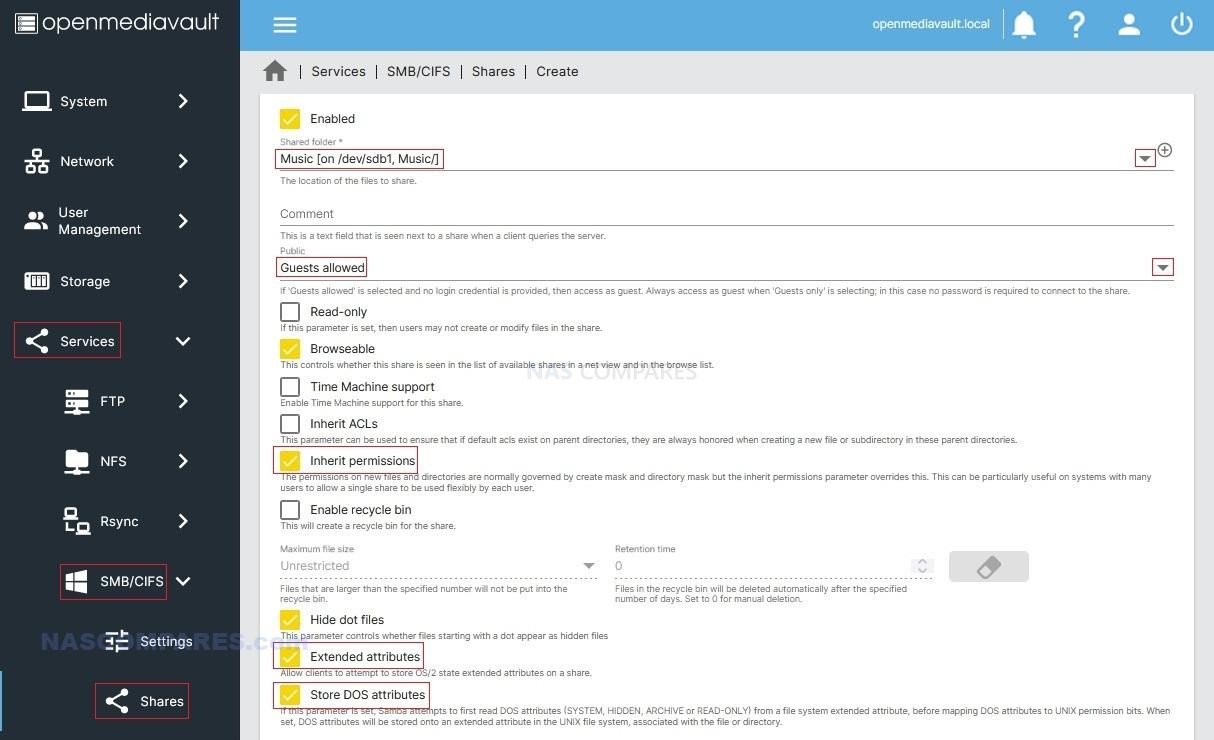
HexOS – A NAS OS Designed for Ease of Use and Performance
Price: TBC – Features 6/10 (Still WiP) – Ease of Use TBC – Release May 2024/2025 – DOWNLOAD (Beta Soon)
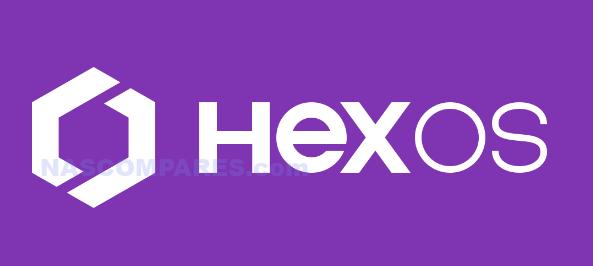
Now, this one is something of a wild card, as HexOS not only seems to be attempting to straddle multiple different elements that are present in other operating systems featured in this article, but it is also still unreleased! HexOS is an in-development network-attached storage software that is being developed by two former UnRAID team members, but is powered by TrueNAS Scale (the Linux version of TrueNAS). At the time of writing, a beta is scheduled for Q3 2024. The creators have been keen to highlight that this new NAS operating system is designed with simplicity and broad accessibility as its primary focus, hoping to combat the need for complex networking understanding and providing an extremely simplified GUI—promising to cut down on the jargon and the headaches, but still benefit from high performance and hardware freedom of use.
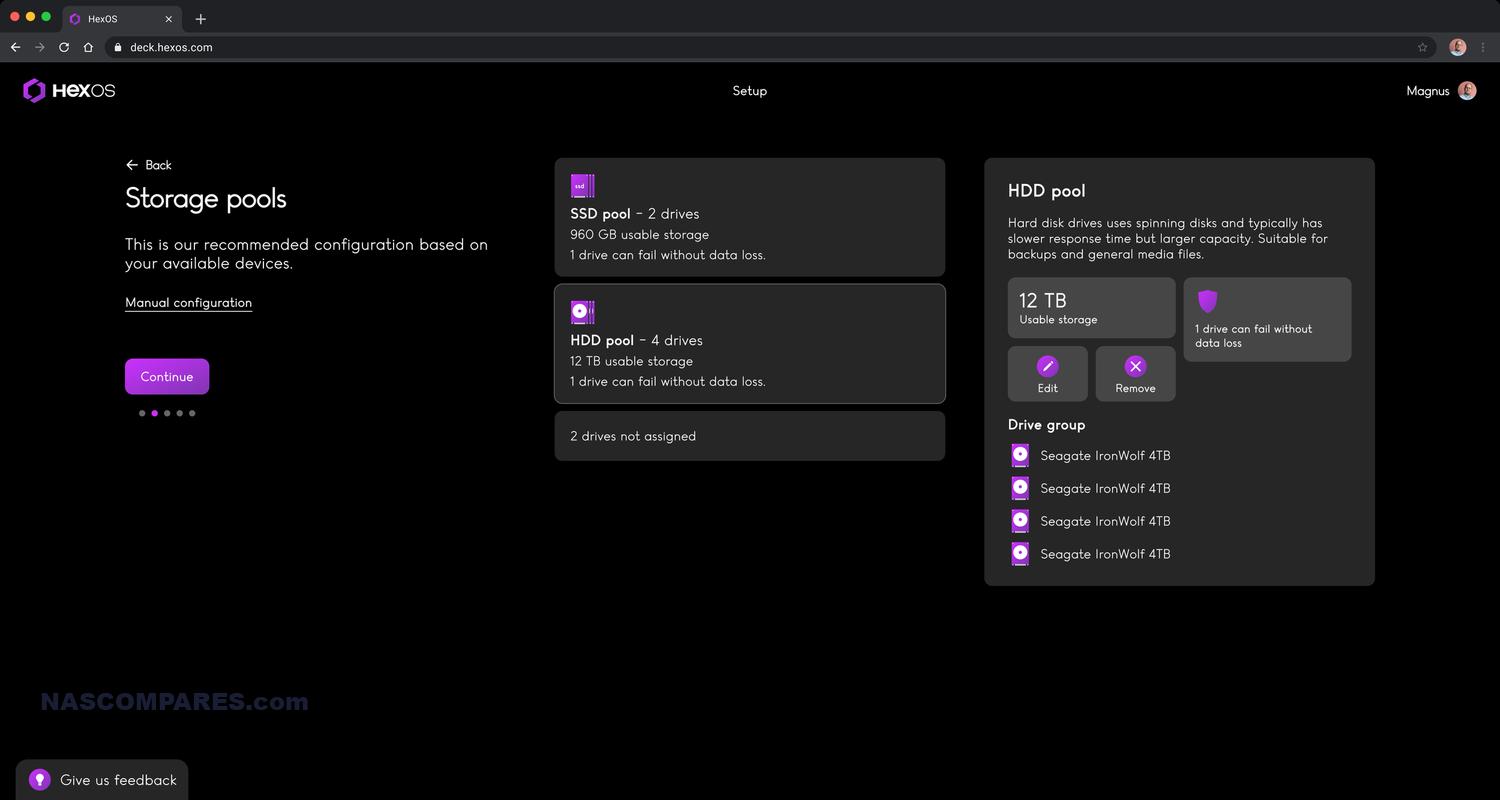
It is a very bold claim to state, and as this list and videos I’ve made online have been keen to highlight, achieving simplicity, performance, stability, and security on a network-attached storage system in a way that novices will still be able to effectively use is truly the holy grail of NAS operating systems. Early images of the intended dashboard and GUI of the software have proved promising, alongside quite bold statements as to what this software will be able to achieve while still maintaining that simplified UX.
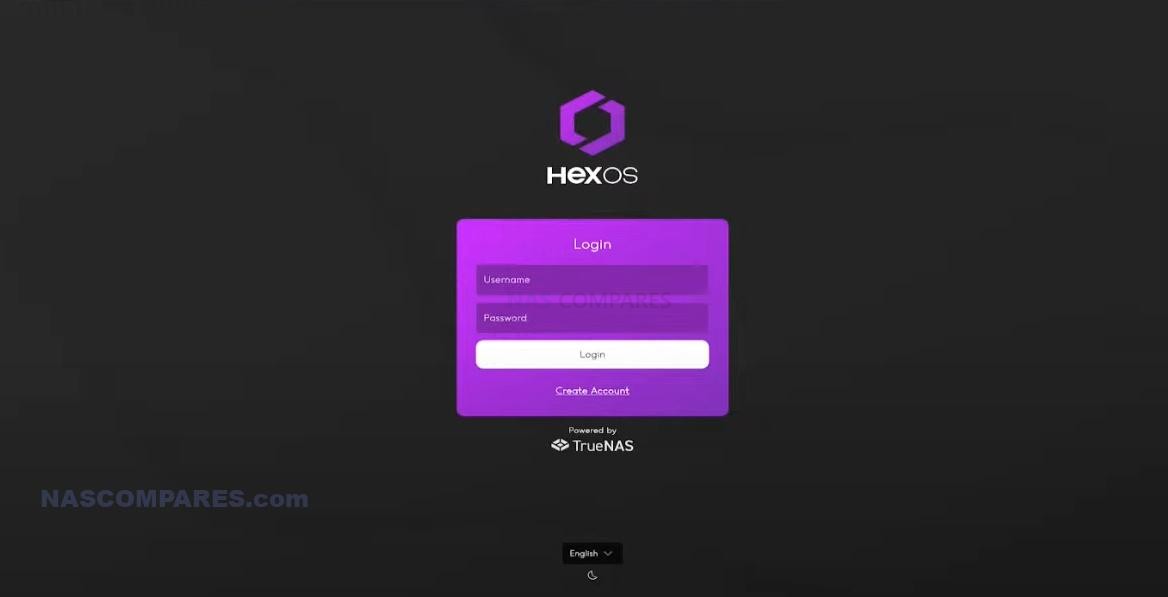
Likewise, notoriety around this in-development NAS OS was also largely increased when popular tech YouTuber Linus of Linus Tech Tips declared that he had invested $250,000 in the NAS OS startup. This, combined with the implied cooperation of TrueNAS and their platform, all add up to some intriguing breadcrumbs that could eventually lead to another great user-friendly NAS software option in the market in the next year or so.
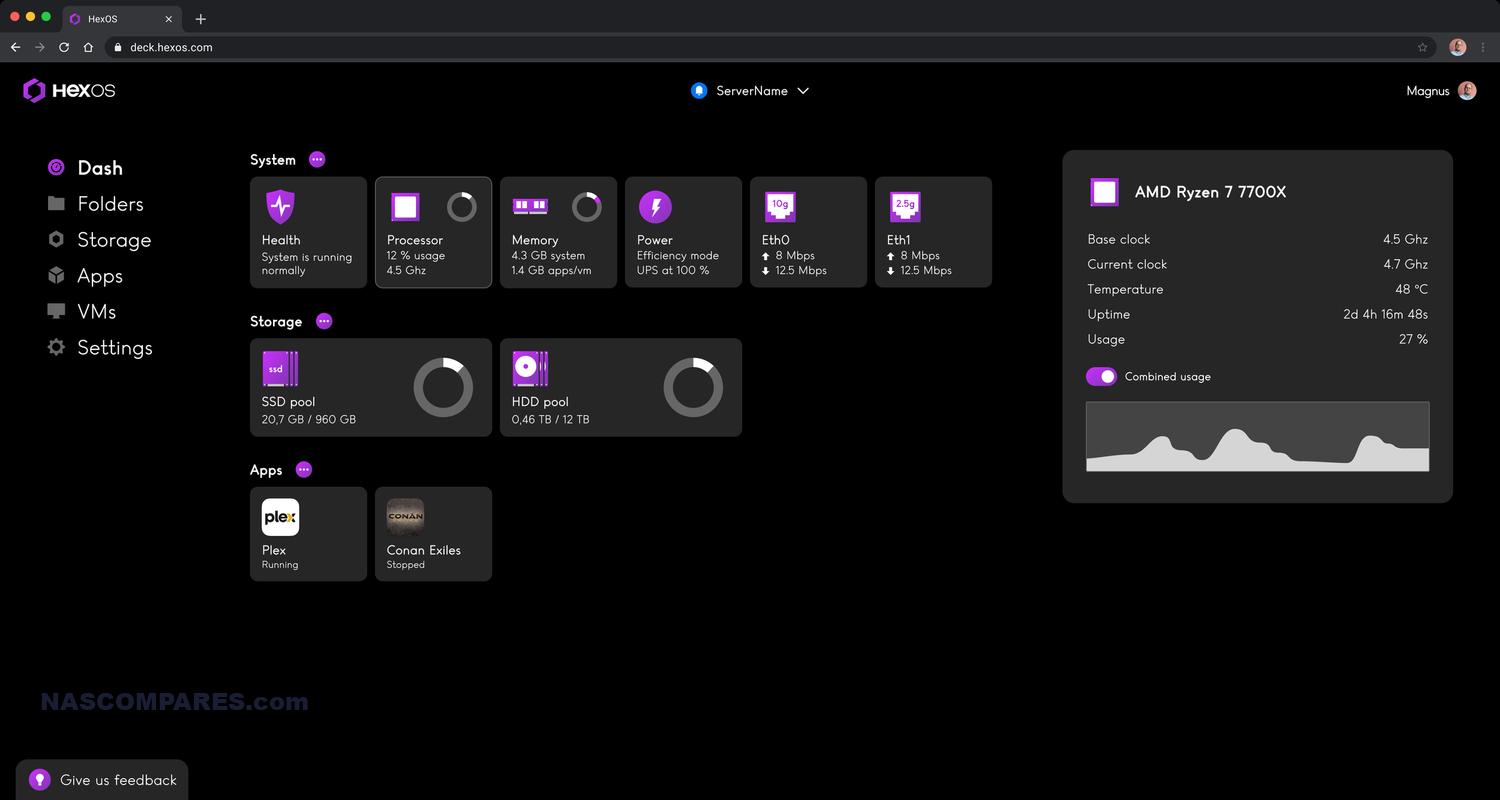
Realistically, even if this software arrives in a public beta later this year, networking software (NAS, routers, etc.) needs a whole lot of stress testing, pen testing, stability checks, QA, and troubleshooting before they can confidently be publicly released, so maybe don’t expect this platform to arrive formally until 2025. Nevertheless, I wanted to include them in this list for those who are looking a little further into the future for when they set up their own private-built NAS solution.
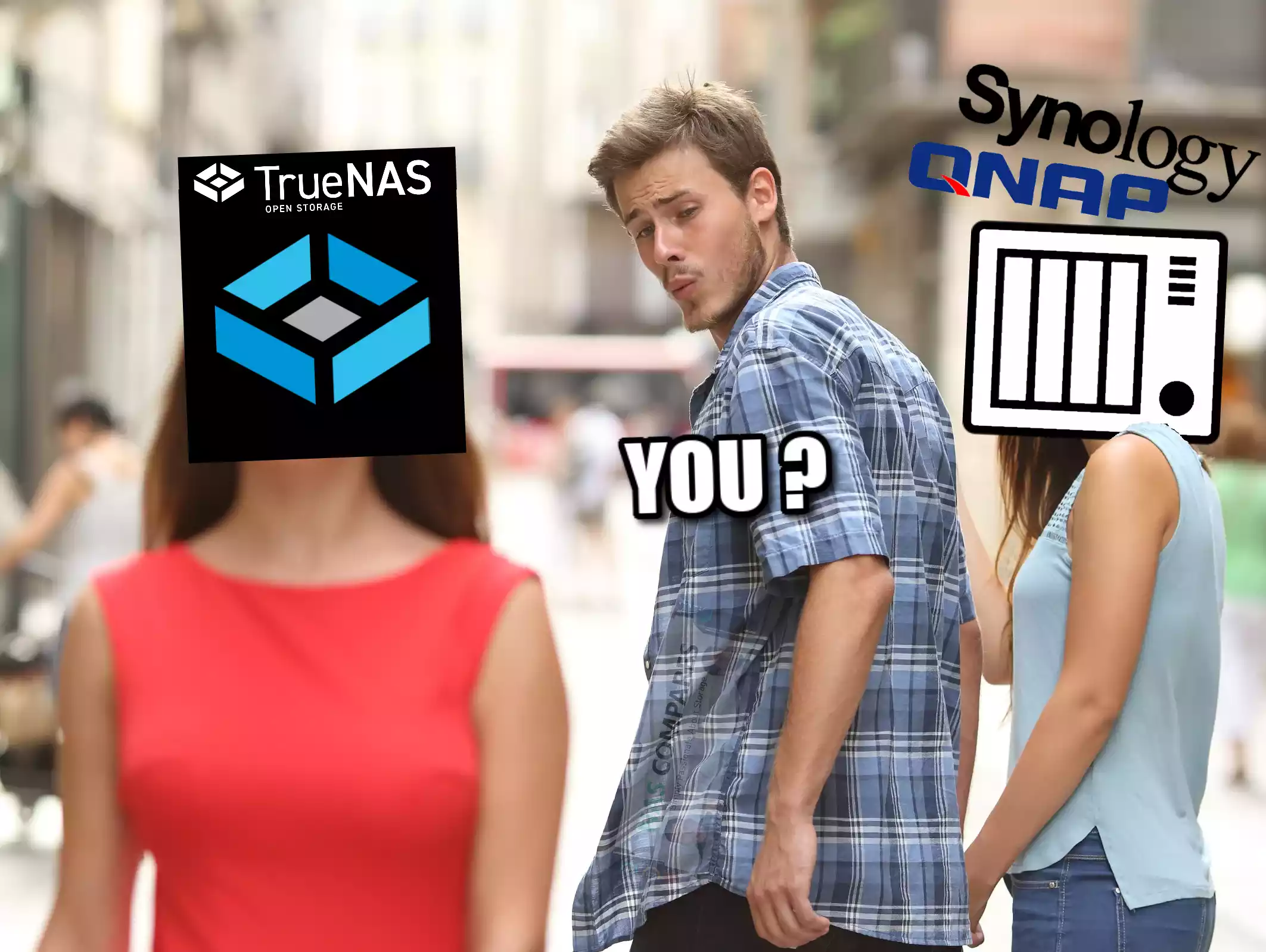
What About TrueNAS Core and TrueNAS Scale?
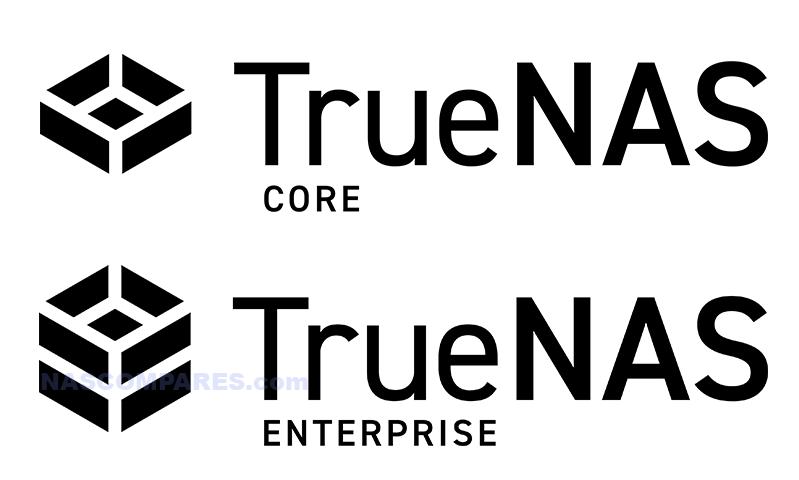
Even if you spent just five minutes looking at recommended software to install on your own DIY and BYO NAS system, chances are the NAS software TrueNAS already appeared on your radar! It would be fair to say that they are currently the number one recommended NAS operating system for those looking for a highly configurable and highly powerful private server solution. However, it would also be fair to say that TrueNAS is NOT a user-friendly platform! If you know what you are doing and have networking or data storage protocol experience under your belt, then TrueNAS Core and TrueNAS Scale won’t be too difficult to wrap your head around.
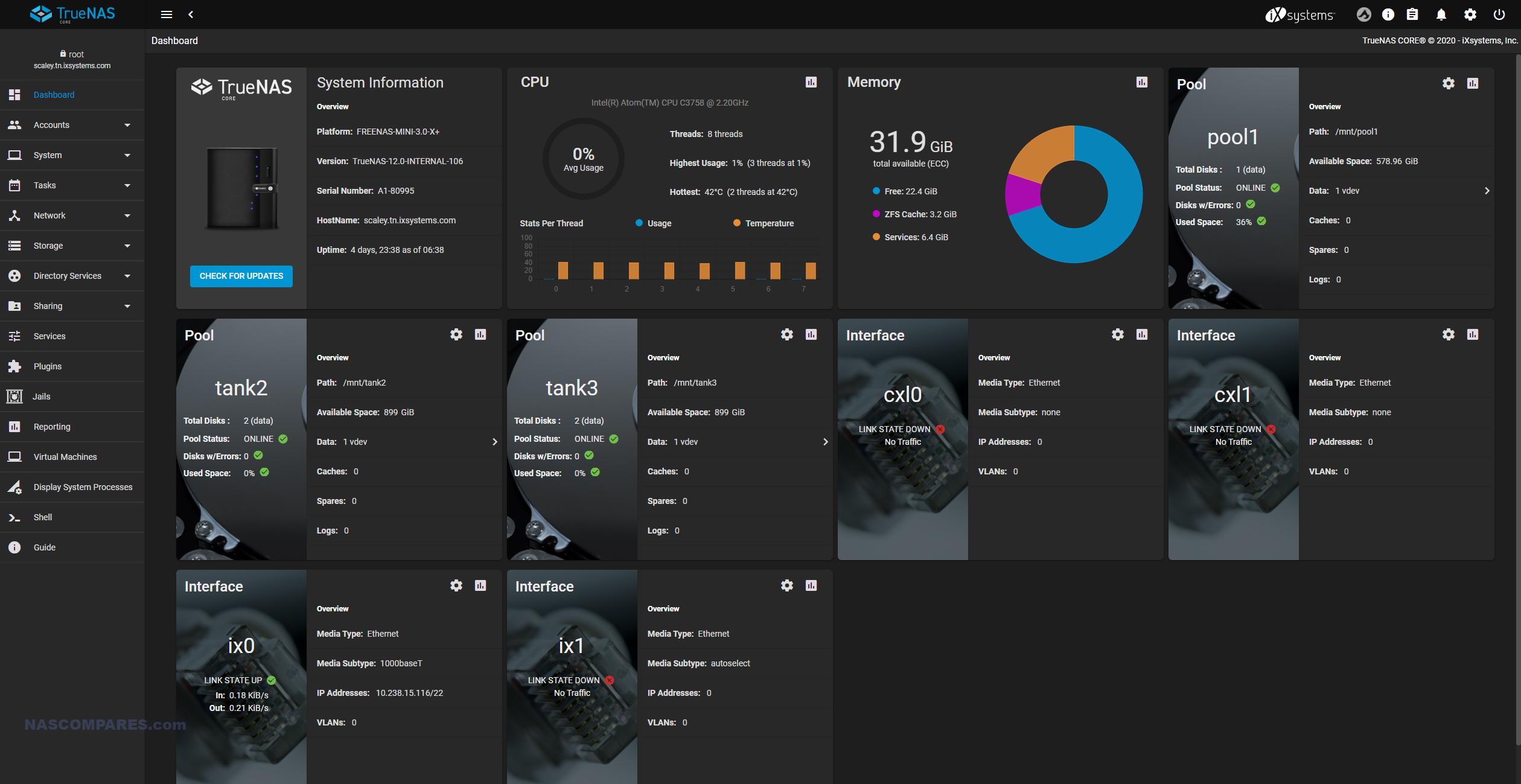
However, the majority of inexperienced or even computer amateur users are going to very quickly hit technical knowledge walls and misunderstandings very early on! Concepts such as storage pools and volumes, although very common amongst NAS OS software choices, are still presented in a very complex form in TrueNAS Core (though arguably, this presentation has been softened in TrueNAS Scale, the Linux variation). Even getting into simple storage access on a file/folder level on TrueNAS Core can be extremely complicated if you only want to manage this via the web browser. Installation of add-on applications utilizing the unique and secure jail system is noticeably more complex than in any other brand out there, and let’s not even get started on how much command line a user needs to either understand or be ready to hands-on utilize to make the most of the system.
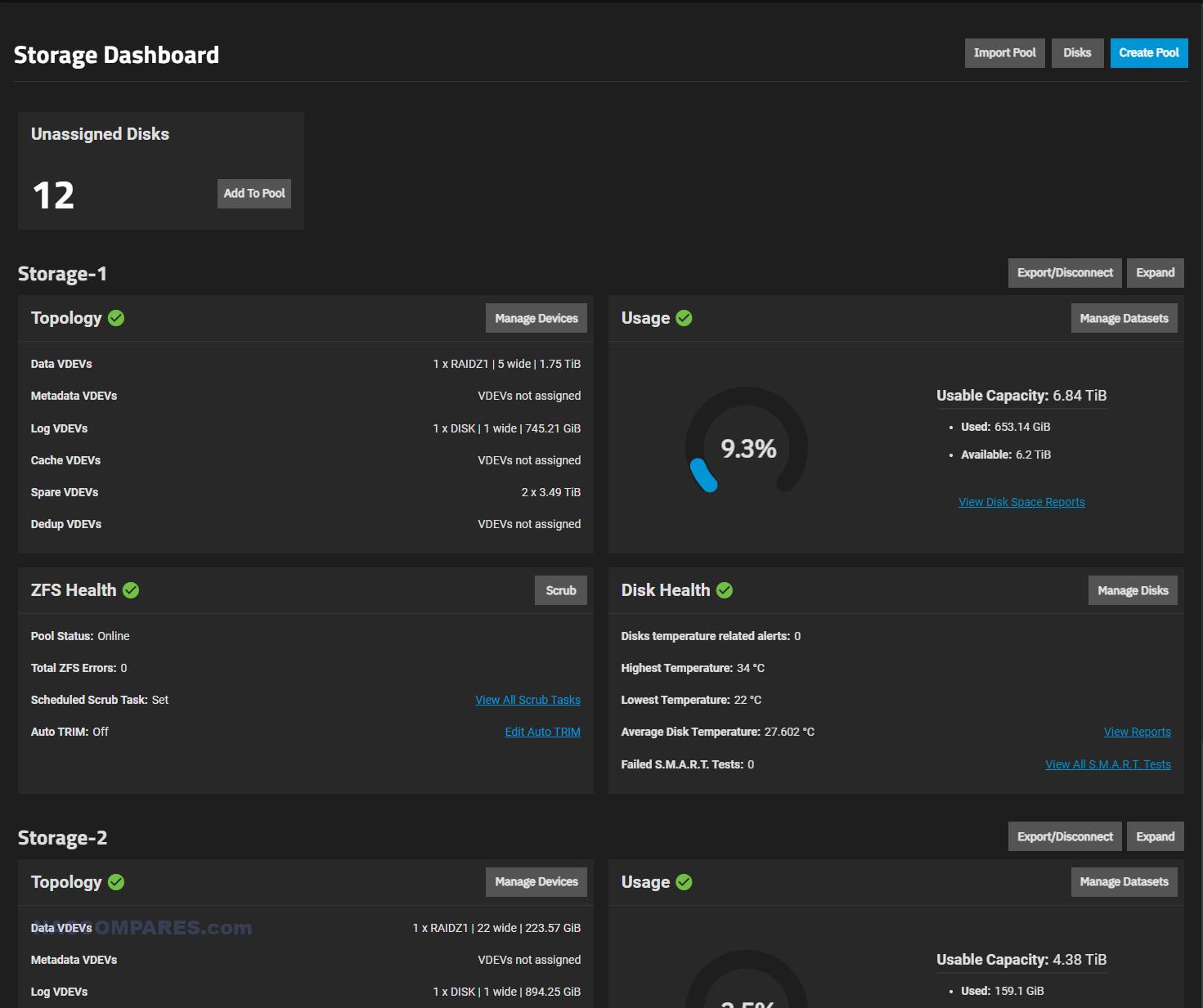
This may all sound tremendously unfair, as TrueNAS Scale and TrueNAS Core do have very well laid out and comparatively intuitive GUIs that are accessible via the web browser, allowing for a full range of control and configuration without the need for a command line. However, the language that is utilized throughout these options is nowhere near as intuitive as other options on this list. And if you are looking for software that doesn’t have a steep learning curve, TrueNAS will prove a challenge for most average users.
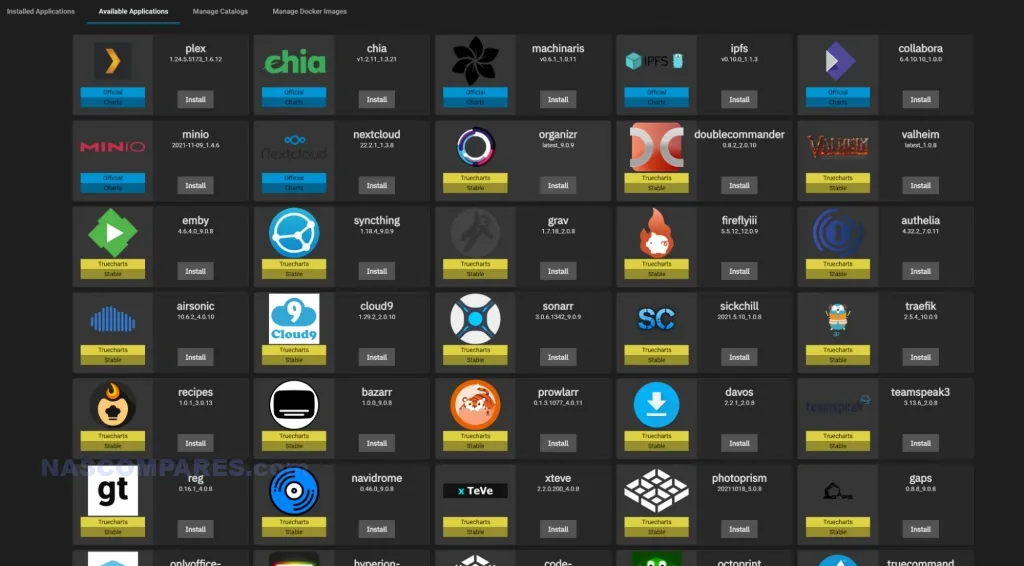
That said, TrueNAS Core and the more adaptable TrueNAS Scale are still among the most powerful and capable operating systems you will ever install on a NAS server system, and if you’re prepared to put in the hours, you are going to have a phenomenally capable and secure system at your fingertips.
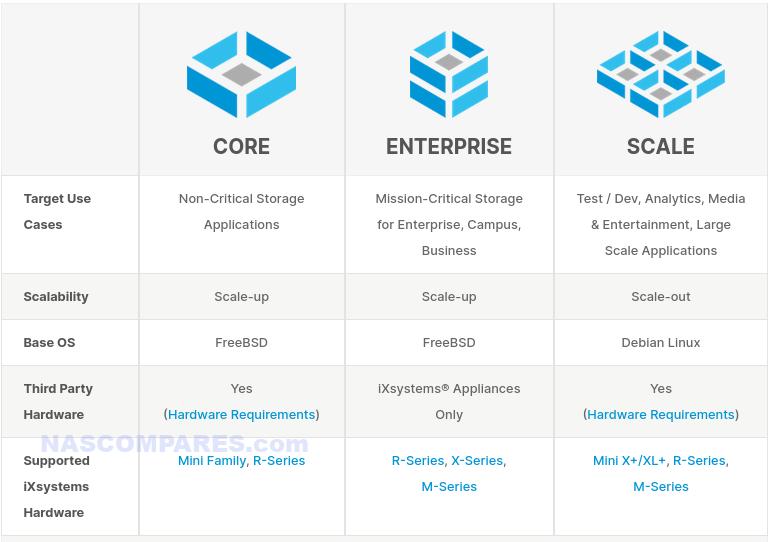
I hope you found this article helpful. Below is a breakdown of some recommended first-time NAS hardware configurations for $250, $500, and $1,000. If this article has helped you, and you want to dig a little further, there are also links below to dedicated DIY NAS and videos to help you get started on your journey towards owning your own data!
| Method | Turn-Key NAS (Synology/QNAP/etc) | Build Your Own / DiY NAS |
| ‘Out the Box’ Setup time
(i.e when it’s 100% setup complete and ready for day-to-day use) |
20-30 Minutes for Build & Initialization
10mins to 12 Hours for RAID Synchronization (ZFS = Minutes, not hours) |
60-120 Minutes for Build & Initialization
10mins to 12 Hours for RAID Synchronization (ZFS = Minutes, not hours) |
| I.T / Tech Skill Level Requirements
(Out of /10) |
Synology = 2/10
QNAP 5/10 Asustor / Terramaster = 4/10 |
TrueNAS Core = 9/10
TrueNAS Scale = 7/10 UnRAID = 6 / 10 |
| Monthly Maintenance
(Checking update, stability, logs, etc) |
10-15 Minutes | 20-30 Minutes |
| Expandability and Migration
(i.e Long term lifespan in Hardware) |
Limited to 1st Party hardware and system limitations (i.e Synolgoy DS923+ supports 1x 5-bay expansion, nothing else. Also, Synology NAS HDD/SSDs can ONLY be used in a Synology NAS)
More Expansions on QNAP, via USB or SAS Expansion Cards |
No hardware limitations (beyond actual 3rd party hardware compatibility)
Can migrate to new hardware easily and with limitless scalability (i.e, 1-1000 HDDs) UnRAID much, MUCH more expandable than TrueNAS currently. |
| Warranty and Repairs
(Options if the event of Issues and/or System Failure) |
2/3/5 Year Hardware Warranty, 1 Party (Brand)
Effective Lifetime Support and Warranty Included |
Multiple Hardware Warranty to manage (Mobo, CPU, PSU, etc)
Community led Support (Forums, Reddit, etc) Paid Support via TrueNAS/UnRAID Official Platforms) |
| Jonsbo N3 + Intel Core i5 12th Gen + 16GB RAM + 10GbE Build
Total $410.65 (i5 CPU + 16GB RAM + 2x10GbE + 400W PSU + Case + Cables) |
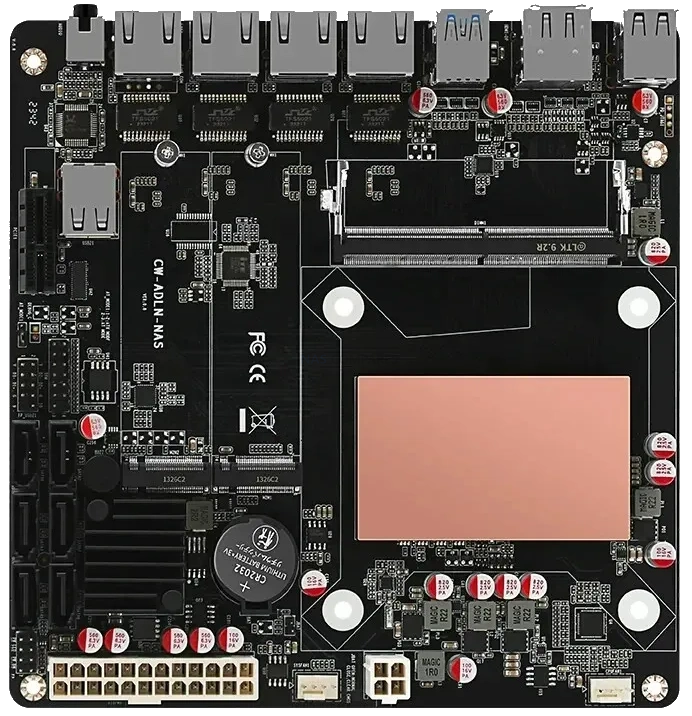
Here are ALL the Motherboard+CPU Combos that we cover in this article:
|
| Jonsbo N3 + Gen4/5 MoBo + Intel Core i5 12th Gen with Int Gfx + 32GB RAM + 10GbE Build
Total £586.63 (Amazon) + £144.76 (Aliexpress) |
🔒 Join Inner Circle
Get an alert every time something gets added to this specific article!
This description contains links to Amazon. These links will take you to some of the products mentioned in today's content. As an Amazon Associate, I earn from qualifying purchases. Visit the NASCompares Deal Finder to find the best place to buy this device in your region, based on Service, Support and Reputation - Just Search for your NAS Drive in the Box Below
Need Advice on Data Storage from an Expert?
Finally, for free advice about your setup, just leave a message in the comments below here at NASCompares.com and we will get back to you. Need Help?
Where possible (and where appropriate) please provide as much information about your requirements, as then I can arrange the best answer and solution to your needs. Do not worry about your e-mail address being required, it will NOT be used in a mailing list and will NOT be used in any way other than to respond to your enquiry.
Need Help?
Where possible (and where appropriate) please provide as much information about your requirements, as then I can arrange the best answer and solution to your needs. Do not worry about your e-mail address being required, it will NOT be used in a mailing list and will NOT be used in any way other than to respond to your enquiry.

|
 |
Beelink ME Pro NAS Revealed
Best SOLID STORAGE NAS of 2025
Should You Worry About the NanoKVM Hidden Microphone?
Best Cheap NAS of 2025
Minisforum MS-02 Ultra - WHO IS THIS FOR??? (The First 48HRs)
Why People Use TrueNAS, UnRAID and Proxmox to Turnkey NAS (Synology, QNAP, etc)
Access content via Patreon or KO-FI
Discover more from NAS Compares
Subscribe to get the latest posts sent to your email.


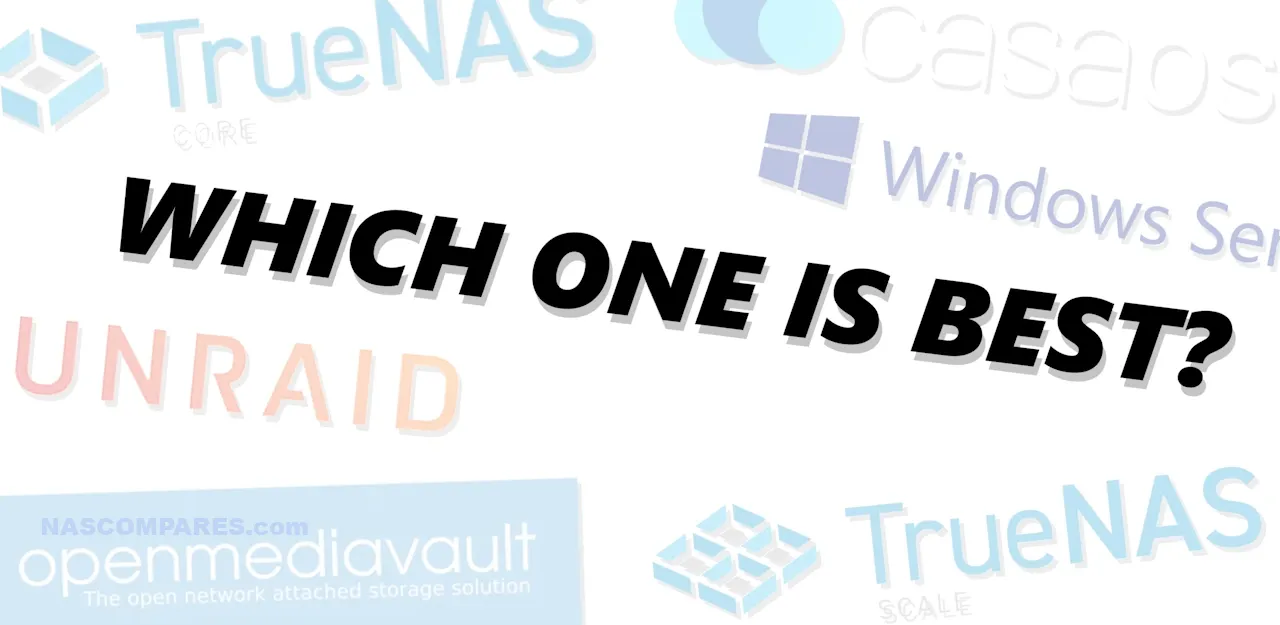
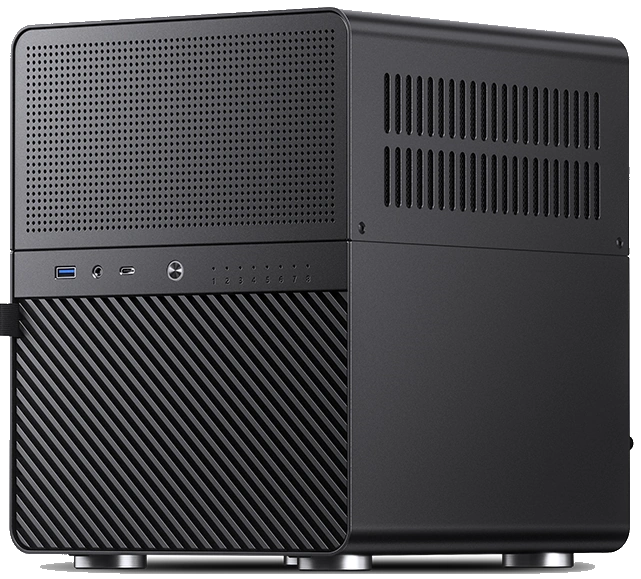



UnRAID is the perfect operating system for 1995.
After 30 years of brainwashing that an OS should look like icons on a photographic background, UnRAID surprisingly felt off the mainstream retro. I thought I would like UnRAID’s dashboard with all the information (UnRAID’s dashboard is well laid out), but with all of the conditioning of the last 30 years I found the UnRAID dashboard to be TMI, stressful and hard to focus on higher level tasks. I am a lot more relaxed working with UGOS and ZimaOS with their background and icon interface more relaxing. My frustration with UGOS and ZimaOS is the lack of books with start to finish step by step instructions once one has the hardware installed (I almost miss Windows NT Server). My current bottleneck is to set up the Docker Compose files securely, one should set up user accounts and then pass the userid number and group id number in the Docker Compose file (my model for this are the Jupyter docker containers with the jovyan user). It is easy to create a non-administrator Jellyfin user account. But, to get the user number and group number I have to run a Linux command at the BASH command line. Ok, so I just click on the terminal icon right? What terminal icon? There isn’t even one in the App Store (at least UnRAID had a way to do command line stuff). A back door method would be to jailbreak a Python docker container, but that would be exposing and relying on a huge security hole. The front door method would be to use SSH. As a one off, I could just SSH using the dynamic ip address, the username and password with the SSH command line supplied with OpenSSH on Windows Pro or Windows 11. But then I am tempted to go down the rabbit hole of setting up the SSH key pair (because?). Then of course there is the rabbit hole of folder structure and file permissions…
REPLY ON YOUTUBE
Casa/Zima is incomplete. Simple, yes. But some of the “features” don’t work like the cloud storage integration. It will do the OAuth, but its not displaying the connection in the File Manager. Needs more work. Definitely a WIP. TrueNAS needs a setup wizard, it simply wants too much information as it assumes *every* install is for an Enterprise. Either that or let the user select a “Home Lab” or “Enterprise” option and leave out the information bloat unless needed. Unraid needs to run off a USB stick? Right. Next. OMV used to be simple and easy, but they are moving to the information bloat as well like TrueNAS. Hex wants money. It was’t reviewed, but the Turnkey Linux File Server which runs on Debian is about as simple as it gets and is very free.
REPLY ON YOUTUBE
If Unraid can be used in place of Ugreen’s OS(Ugreen OS is not Linux friendly) I am okay paying for it. Have you replaced a Ugreen OS with Unraid? Thanks!
REPLY ON YOUTUBE
Hihow about rockstor aß nas System any comments to that
REPLY ON YOUTUBE
Because not all drives need to work all the time, in a long term, it saves you money on energy and increases longevity of drives, not to mention the noise. It’s a game changer for big homelab arrays.
REPLY ON YOUTUBE
Can you also make a video explaining pros and cons of zfs vs xfs vs btrfs file systems?
REPLY ON YOUTUBE
unRAID is way too expensive. Not worth the price at all. CasaOS, ZimaOS, TrueNAS, HexOS, and OMV are way better.
REPLY ON YOUTUBE
I arrived to this video after getting my nose bleeding with TrueNAS…anyone else?
REPLY ON YOUTUBE
I am beginning my Unraid journey while I spec out my next build. You mentioned the OS runs off the flash drive. My understanding is it runs off a RAM drive loaded from the USB, and the only time it talks to the USB is booting and config changes. Did I misunderstand?
REPLY ON YOUTUBE
Wow the price has really went up since this video
REPLY ON YOUTUBE
unRAID do not have good financial and marketing advisors. Pricing the product so expensive will result in ultra low market share. This is a good way to go out of business.
REPLY ON YOUTUBE
Any changes since this content was posted? What is the difference between the 100$ and the 250$ licenses? It isn’t clearly stated on their site as far as I can see.
I assume it is a license per machine? Can it run virtualized on proxmox?
REPLY ON YOUTUBE
I really, really want to like TrueNAS but the permission is a total train wreck. I can get permissions working on one dataset, but then try again with a new one and it doesn’t work. 2025 and it still needs to be overly complicated?
REPLY ON YOUTUBE
I find it funny that you say with casa os you need no terminal or command line stuff but on their site you can view a live demo and to install it let’s you copy the command to install through terminal! LMAO
REPLY ON YOUTUBE
Pro tip, Casa OS can be installed alongside OMV. This is how i have mine set up.
REPLY ON YOUTUBE
You forgot to add, that the paritysystem also limits you on how big a drive you can add.
The added pool HDDs can never be bigger than the smallest Parity. You have a 8TB parity and want to add a 12 TB pool disk? too bad that pool disk will only use 8TB of it’s capacity. Not to bad, if you buy a relatively big parity right at the beginning., but you gotta know it.
REPLY ON YOUTUBE
Completely green on this subject, just getting into it. I have about 12 old desktops, 5 or so mini pcs, and about 5 old laptops. Could i frankenstein and Unraid and run Plex? I strictly want to use it for my movie library in the house and nothing else. I have a lot of physical media i have collected as i live out in the countryside and lose services all the time. Thanks In Advance!
REPLY ON YOUTUBE
I’m sat here installing Windows 11, £3.99 for a Pro license and it’ll do what i need it to do (hopefully)……i wish these other options had such a useable UI, you say “command line”, i leg it.
REPLY ON YOUTUBE
I just got the email from HexOS. 99 dollars for an early bird license, but after beta is over it will move to subscription. Licenses seem to be tied to the hardware, not an account. Also, apparently the OS is always only, which is something I don’t want from a NAS OS.
REPLY ON YOUTUBE
I mean, TrueNAS also only lets you access its web UI from the root user
REPLY ON YOUTUBE
I used OMV 5 for quite a few years and it was pretty solid. Mapping folders for docker containers was a pain but everything else was very good and performance was great! I will have to check out the newest OMV to see what the improvements are. For now using truenas scale and liking it very much! I do want to play around with casa OS too.
REPLY ON YOUTUBE
As of now the pricing has completely changed. The pricing plays around with OS security updates which are included for just one year with the starter and unleashed licenses. The Lifetime, with everything unlimited, OS updates too goes for 249$.
249$ is the price of a used 2 bay Synology, or a new J series 2 bay Synology, which includes all software
REPLY ON YOUTUBE
I vote for Rockstor. It’s a lot easier to add and remove disks from a pool, deal with existing filesystems on drives and manage LUKS encryption, compared to OMV.
REPLY ON YOUTUBE
🙂 XigmaNAS® 😉
REPLY ON YOUTUBE
Really need to change the icon to a seagull. They own your channel
REPLY ON YOUTUBE
Been using TrueNAS for a while. Although the learning curve is steep, the KBs are insane. Any issue I have ever had could be quickly and easily searched in the forum or on YouTube. Fairly simple.
REPLY ON YOUTUBE
I do not find Unraid to be user friendly in any way. Too many basic features need plugins. And this is coming from an IT Pro with nearly 20 years of professional experience and nearly 40 years (basically my whole life) using a PC. Relying on a USB stick as the boot drive is stupid and unreliable. Network and file system configuration for docker images is too Linux centric so it confuses a Windows Admin, and will confuse the average user.
REPLY ON YOUTUBE
I love OpenMediaVault the most. Why do I like it better than TrueNAS? The answer is ZFS vs. other file systems like ext4 and Btrfs. ZFS doesn’t support adding disks to an vdev, only adding vdevs to a pool. You cannot expand a RAID, and you can’t combine drives of different sizes without wasting the extra space of the larger drives. OpenMediaVault, on the other hand, supports ext3, ext4, and XFS, and I think Btrfs.
As for DIY NAS, I don’t like the layout of Fractal Design Core or Node, such as the position of drive bays, and Jonsbo NASes like N1, N2, and N3 are kind of dated, using SATA SSDs and not M.2 NVMe. I like U-NAS for mini-ITX NAS and Silverstone for ATX NAS.
I’ve been trialling UnRAID for 2 weeks now and its been frustrating. It locks up on 4 out of 10 bootups at random points – have to hard reset. Before UnRAID I test ran Win10 on the box for 3 weeks, hammering the system and it was perfect. Booting off new USB2 flash disk in a USB2 port. i7, 16Gb, LSI9207-8i HBA, 10Gb ConnectX3 SFP+, Gigabyte Z97X with 9 Exos & Ironwolf drives, one NVME 1Gb as cache.
Doing the first parity sync with 10 empty drives took 20 hours. A week later a scheduled parity check, still all disks blank, another 20 hours!! Copying to array (spinny drives dog slow, only the NVME cache drive gives decent speeds). Today I messed about with vm.dirty ratios to speed up the awful 35Mbps crawl. Dumped a 100Gb file on and within 60 seconds UnRAID freaked out, locked up, reported read errors on all 10 drives simultaneously!
Took the array offline, all 4 CPU cores redlining constantly. Refused to reboot / shutdown so did a hard reset. It came back up with one disk disabled. Reset ratios back to defaults, took it into maintenance mode, unassigned drive then started a rebuild – completely blank drive and its estimating 18 hours for a rebuild. Then I discovered UnRAID 6.12.11 has some incompatibility with 6/ 8Tb Ironwolf drives, you have to edit /flash the disk firmware. WTF?? Problem only started since 6.9.x.
All I want to do is use UnRAID as a NAS backup system. No dockers, VM’s or media serving. This is way too temperamental for my liking, I like the system but the lack of stability and insanely long rebuilds / parity checks is beyond a joke so confidence is a bit low…
REPLY ON YOUTUBE
How secure are these fos for nas ?
REPLY ON YOUTUBE
I started using ubuntu server 2 years ago and i have to say i have no idea why nobody recommends ubuntu server. its easy to poke around and find out how to get things up and running and every time i googled a solution i found what i needed with little trouble. all these os options are so bloated, people really need to try using ubuntu minimized. its not difficult to set up your raid array with a few commands.
Where are all my ubuntu server nerds?
REPLY ON YOUTUBE
Just gonna throw it out there I would love to see you make some content on casa/zima OS. I recently got the UGREEN kickstarter nas and while I really like the base that they have with UGOS there are way to many people reporting data loss and security issues for me to trust my data on it.
So this was the perfect video for me to see and get started but if you make more content around it that would be sweet.
REPLY ON YOUTUBE
My simple NAS setup is OMV for storage, file and user management, then add CasaOS added to it for container management.
REPLY ON YOUTUBE
If you need not only NAS – Proxmox. Simple SMB share is there in the box
REPLY ON YOUTUBE
1:27 “I hate seagulls” would be an excellent merch idea. If you make it, I’ll buy it.
REPLY ON YOUTUBE
Oh cool you have a zima cube, my pro arrived this week, tried zimaos, truenas, xpenology, and proxmox – no conclusions yet
REPLY ON YOUTUBE
I wouldn’t touch anything that Linus tech tips is involved with.
REPLY ON YOUTUBE
While I have OMV on Raspberry pi’s it is not the easiest for me. Found them very painful to set up shares. Truenas was easier to set up and manage
REPLY ON YOUTUBE
True NAS is easy to install…. CORE is way better than SCALE.*
REPLY ON YOUTUBE
I 10000% agree on the need for some sort of storage wizard with Unraid. I’ll bet they lose a lot of potential customers at this step because it’s not clear exactly what you need to do to, you know, get the storage set up on your NAS. Even basic stuff like clearing/formatting disks is more arcane a process than it should be.
REPLY ON YOUTUBE
In my opinion a NAS system that doesn’t need command line configuration is pretty much needed for most users. The thing is while I can learn to handle almost anything using command line the NAS is a system I will set up and never touch again unless I need to change a disk or add more drives. And with the way I recommend configuring your NAS that could be five years down. And there is no way I am going to still know what I did when setting up the system or what commands I had to use.
In fact I worked for a computer company building and selling servers, workstations and components. For several years we were using a server running Banyan Vines, but one day it started to have problems. It took me several hours just to find the server as no one remembered were it had been installed. When I found it there were no keyboard or monitor as those had been nicked. Well it turned out that after all these years the HDD was full. No one really remembered anything about configuring the server or how to add more drives. Banyan Vines was a UNIX based system and no one knew anything about actually using it. Years back I worked as a Unix administrator certified for several versions including IBM AIX, but a few years of not having to use Unix degraded my memory to the degree that I had to dig into the manuals and start almost from the beginning. In the end I just cleared temp files and compacted the databases and when the server was working again I built a NT3.2 (I think that was the version) server with faster and larger HDD’s, a tape backup integrated and set up automatic tape backups running every night. This was far easier than trying to get that Unix machine working with new drives. Supporting this machine was way easier than trying to handle Banyan Vines.
REPLY ON YOUTUBE
Openmediavault is so good. It’d be nice if you could go into omv-extras and the plugin system in the future. The cli isn’t needed for most people.
REPLY ON YOUTUBE
UmbrelOS is also a good easy to use alternative. Similar to CasaOS but with a better appstore
REPLY ON YOUTUBE
Nice breakdown Robbie. How about a low power NAS series? I’d love to see you build OMV on a phone.
REPLY ON YOUTUBE
My mate deadset told me to get TrueNAS, I went to youtube and looked up *insert nas here* tutorial and Spaceinvader One is the WHOLE REASON I went with Unraid. Setting up VMs and troubleshooting graphics card passthrough would be IMPOSSIBLE for me without him as a total NAS noob.
The rest of Unraid really is a good experience.
REPLY ON YOUTUBE
While OMV doesn’t support ZFS out of the box, there is a plugin available to add ZFS management to the web UI. OMV is just debian underneath, if you know what you’re doing, it’s a very flexible solution.
REPLY ON YOUTUBE
I use OMV and I very rarely use the cli, once you install the OMV Extras, you can do virtually all NAS stuff.
It’s got a brilliant docker plugin, which does away with portainer, built in editing of compose files, backup and restore built in.
OMV has a KVM plugin, to do virtual machines and lxcs.
A kubernettes plugin has just been added.
You can use the ZFS plugin as well.
I like OMV as a JBOD box, with a AMD5600, it does my cctv and a stack of containers.
I don’t think the bigger YouTube channels give OMV a fair crack of the whip, for a free project that runs on such a large hardware base, it’s too easily dismissed, plus there are very good guides and a active and helpful forum.
It will be interesting to see if truenas still makes docker a mess going forward, but I’m not sure their docker system will be as good as the compose plugin for OMV.
REPLY ON YOUTUBE
Was considering TrueNas given the great hardware with Ugreen but apparently “not ready for primetime” software and watched your and several other creator’s Install and setup guides i’ll be honest, It was way more than i wanted to do. It’s not that it was above my capability. It was above my interest in amount of time i want to spend and learning curve i want to scale. I’ll have to check out unraid but man ritght now i’m definintely leaning towards something easier or a qnap system or maybe synology will wake up and stop releasing shite cpus for regular consumers.
REPLY ON YOUTUBE
I’m a TrueNAS guy, but I have to admit that enjoyed playing around with OpenMediaVault — my first NAS build, years ago, ran really low end hardware and OMV worked like a champ.
REPLY ON YOUTUBE
Loving UnRAID so far, imagine it’s not ideal for enterprise type stuff. But as a home hobbyist it’s awesome as it’s very capable without being overly complex. But it does have just enough complexity that it’s been good fun learning stuff.
REPLY ON YOUTUBE
unraid requiring you to forever boot off a usb, instantly disqualifies it as a NAS in my opinion
REPLY ON YOUTUBE
unraid requiring you to forever boot off a usb, instantly disqualifies it as a NAS in my opinion
REPLY ON YOUTUBE
unraid requiring you to forever boot off a usb, instantly disqualifies it as a NAS in my opinion
REPLY ON YOUTUBE
what timing, the rest of the parts are coming in today for a DIY NAS I’m looking to build for the 1st time. using your Jonsbo N3 800usd template BTW.
REPLY ON YOUTUBE
what timing, the rest of the parts are coming in today for a DIY NAS I’m looking to build for the 1st time. using your Jonsbo N3 800usd template BTW.
REPLY ON YOUTUBE
what timing, the rest of the parts are coming in today for a DIY NAS I’m looking to build for the 1st time. using your Jonsbo N3 800usd template BTW.
REPLY ON YOUTUBE
True charts is a dead project now. Truenas scale is moving to have native docker support in the next release. Another alternative to casa os is Cosmos.
REPLY ON YOUTUBE
Any reason you skipped over Xpenology? Tough install, but absolutely blows the rest of the options away on UI once installed.
REPLY ON YOUTUBE
Thanks for this ! So if i want a NAS OS to use a box with HDDs into it and not any other software, OMV seems to be the way to go.
REPLY ON YOUTUBE
I haven’t tried the three mentioned in this video. I really wanted the simplicity of Synology software, but with my own hardware (i5 14500, 32GB RAM, and more) I hosted a bunch of stuff on Proxmox and used a saved Synology CM from a group (or dude) called HJS (dude on video sounds Scottish).
https://youtu.be/Z6dO2RDOIRQ?si=UczjvAtGyynvesPv
I followed this video, but I’m not sure if the download is available anymore. I do have a copy of it that I could host elsewhere ???? not sure of the legalities of using this tbh.
REPLY ON YOUTUBE
I was just thinking of asking this after your last video about unraid and truenas.
REPLY ON YOUTUBE
For me, the most important feature of UnRaid is that every drive is completely self-contained. In the case of a major failure, you can remove individual drives and plug them into another computer and retrieve all the files stored on those drives. In most RAID systems, the data on individual drives is not usable without all the other drives.
It is also very easy to set up dual-parity with UnRaid, which allows for the failure of any two drives simultaneously. This is very comforting when you have a drive failure and have to replace and rebuild a drive – with only single parity, if another drive fails during the rebuild process, you will lose data. Dual-parity keeps you protected while replacing a failed drive. Again, if MORE than two drives fail at once, all of the data on the functioning drives is still retrievable.
I have lost two other RAID arrays in the past due to hardware failures and lost everything. I don’t want to go through that ever again.
REPLY ON YOUTUBE
TL;DW – Only use unraid if you’re a based gigachad
REPLY ON YOUTUBE
I tried unraid I really like it, its simple to use and runs fast, I run my own media server, well I tried truenas scale thats great but I cant gte sonarr to import my tv shows when downloaded on unraid it works just fine and did not take long to setup, I wish there would be an option to install to a hard drive, the only thing which really is stopping me from pulling the trigger is this 1 year of updates if I am going to spend $50 on 1 year I would expect to get security updates after the one year, paying $250 is not an option its way too much for what it is.
REPLY ON YOUTUBE
For the transfer speed and performance, should I be worried if I’m only using sata SSD for storage and Nvme for the system/minecraft/docker…?
Because in the future I intend to have something capable to do at once 3 or 4 jellyfin steam, a surveillance system recording in a loop and a minecraft server…. so lots of reads and writes
REPLY ON YOUTUBE
If using ZFS can you still mix and match drives without losing space? Or does it have to be BTRFS? This is one of the most important features to me when choosing NAS software.
REPLY ON YOUTUBE
the way unraid stores its data and accesses them one at a time (vs traditional raid) was one of my main reasons for going with it. I liked that you could still have dual parity but if something crazy happens and a third drive dies before you can replace the first two then you only lose the data on that one drive. For a media server its pretty perfect at least for my use case. I have 4 or 5 streams max going at once and never have any issues. It saturates my 1gb network regardless even when writing directly to the array over the network since i dont write to cache drives.
REPLY ON YOUTUBE
I have been through all sorts of NASes. FreeNAS, TrueNAS, NAS4Free and Synology. Last year I built an Unraid system. I run it with containers for immich, paperless ngx and plex. And I am quite happy with it. I have about 28 TB of disk capacity distributed over 7 HDs, two cache SSDs (mirrored via zfs) and it works perfectly. Is it fast? No. A ZFS system is faster. But there are three major advantages to it.
1/ all files are residing on one of the disks and not striped over several disks. Therefore, in case of a major incident I can still access most of my data.
2/ the power management is excellent. The system only spins up the disks which is needed for access. So for example, if I stream a tv show via plex only one of the drives spins up, reducing the energy consumption significantly. And in opposite to FreeNAS the disks are really spinning down, when not needed. I can vividly remember how long I tried to make the spin down happen in FreeNAS and NAS4Free. My server is consuming idle about 15-20 Watts and it is idle most of the time.
3/ I have control over my cache drives. So for example the containers and virtual machines are fully residing on the mirrored cache drives. The HDs are only spun up when the write cache is written to them at night or when they accessed in a read-mode.
So all in all I am very happy with the solution.
REPLY ON YOUTUBE
As someone who works with TrueNAS and ZFS daily, I like Unraid because I don’t have to think too hard to use it. Some might say this sucks the fun out of life, but when I just want some network storage dammit, it’s a welcome change of pace.
REPLY ON YOUTUBE
Unraid is fantastic, especially for a home server you’re cobbling together with random parts. My first server I started with lower capacity hard drives (few 6TB hdd). When I needed more space, I bought a larger hdd and replaced the parity disk with it. I then moved the old parity drive into the array. I’ve been doing that until I got to 14TB parity drive. From here I’m just adding drives directly to the array.
I’m now building a second system out of spare parts and looked at some alternatives such as TrueNAS. However I keep coming back to Unraid due to it’s flexibility and ease of use. Yea you gotta pay but it’s not much for a basic license and you can upgrade as you go.
REPLY ON YOUTUBE
for everyone in europe, keep in mind; these guys are doing big-time tax-evasion. so since police can’t catch unraid, it’s up to you to pay tax on top on your own.
REPLY ON YOUTUBE
Pro: nothing
Con: $120 for buggy, buggy, buggy, stupid, buggy, system without official support.. did i mentioned buggy?
If you living right next to your data and willing to fiddle with it, go for it. If you want a solid system, go for TrueNAS
REPLY ON YOUTUBE
It’s better to not have an answer of a question if the answer is sooooooo wrong !
REPLY ON YOUTUBE
I tried this due to my experimentation with different NAS systems. I use a QNAP, but have interest in TrueNAS, UnRAID, Promox and others . So far Truenas is OK, but the VM part is lacking. Proxmox has the best (in my opinion), logon from the web so users can operate from the web. My only problem, is I can’t get solaris 10 to find the NIC. However Unraid, doesn’t look like it will easy for normal everyday users. I dumped it. Maybe later if it gets better and I can boot off an SSD…….
REPLY ON YOUTUBE
what horrible teeth!
REPLY ON YOUTUBE
Very nice summary! You earned a new sub!
REPLY ON YOUTUBE
Yes they do give you 30-day trial but you can also extend that for another 15 days I’ve done it at least that was 4 years ago
REPLY ON YOUTUBE
Yes it’s true unrated requires it to boot off a USB but once booted it runs off RAM and I like unraid for what they offer apps good documentation online space later one is one person that you can go to
REPLY ON YOUTUBE
good to know all these, thank you. when you are saying about the 3 options to pay for the software and you say “interfaces”, what does that mean? actual disks inside ONE nas or separate computers acting as a NAS with whatever storage each?
REPLY ON YOUTUBE
Disk speed performance – old default array using xfs or btrfs, yes disk speeds suck
now, using BTRFS pools on SSDs/nVMEs with raid configs you get raid speeds
and even newer… using ZFS pools… you get ZFS speeds.
REPLY ON YOUTUBE
Correction: the OS is stored, and loaded into memory from a USB stick.
the OS runs on the memory of the system. your registration key is also tied to the UUID of the USB stick so if the stick dies, you need to re-register your new stick. it can take 20 seconds to a couple hours to receive your new key. These days its usually in the seconds range, but there is a limit to how many re-registers per year before you need to contact support, which could be from hours to the next day. I run unraid. this is not usually an issue unless you buy crap usb sticks.
REPLY ON YOUTUBE
You are right, initial setup of the disks and figuring out what the heck is going on with the preclear/parity check is annoying to a first time user. I stumbled thru the setup on old hardware, then built a fast new multithreaded server with the 3) 8tb ironwolf and a 1tb wd as a cache drive
REPLY ON YOUTUBE
1 – massive benefit to unraid is you can pass through nearly any disk format within a few clicks of the ui. This is a massive benefit if you have disks with data on it already. I think the best setup is to have a small node with unraid for apps/ external drives then a proper nas as data storage.
REPLY ON YOUTUBE
Unraid is for newbs that don’t know what they are doing and proxmox is for people that do
REPLY ON YOUTUBE
Another option. For Windows based users is Drivepool its cheaper and does the drive pooling which can be expanded at will and you have options for duplicating data on a schedule. it doesn’t have parity but it writes files to one disk at a time swapping drives each time spreading them across the drives in that fashion like Unraid. If you remove a drive all the files on that disk are copied to the other drives during the removal procces and are still there and readable by anything that can access Fat32/NTFS. Drivepool also has caching aswell.
Now Unraid obviously has many additional functions and is more efficient and better performance but if all you want is a file server.
Personally i like the idea of Unraid and used it in the past on older systems but for some reason my hardware is locked so i can’t test it out on either of my systems and tho it detects my onboard 1Gb standard intel network it wont connect to the internet at all. Also i’d be in the Tier 2 price which i can’t justify.
TrueNas Core is great in theory but in my case it’s hit and miss with my Marvell based 10Gbe network cards and the pools keep dissapearing and or permissions keep denying access.to my windows main pc.
REPLY ON YOUTUBE
Thanks for the video.
I plan on reusing an old gaming rig as a nas using unraid. It was nice to get your thoughts on it.
REPLY ON YOUTUBE
After playing around with Unraid the biggest problem is it’s slow. Yes you can speed some things up by using a cache disk or disks but if you are moving large datasets around a 10G network it’s pretty terrible. For 1-2.5g networks though it’s not bad if you don’t want to DIY something with mergefs and SnapRAID. It’s kind of like buying into Synology if you make an informed choice you will probably be happy with it so long as what you are doing is within what it’s meant to do.
REPLY ON YOUTUBE
Its what drobo should have been. Not striping is good for most home servers, less energy and wear.
REPLY ON YOUTUBE
I rarely comment on Youtube, but I just have to say , Nice Job. I’ll 100% be watching your other vids. This seems like exactly what I need. Not worried about speed. Just want a place to sync my QNAP to and have a bunch of random HHDs and SSDs. The PC ITX box is half decent 5 years ago so it should be good for VMs I also want to run. Thanks Mate!
REPLY ON YOUTUBE
Important notes and tips:
1. Unraid REQUIRES a USB stick (i.e. you can’t boot off SSD, not even an eMMC chip), which is both a pro and a con. If your stick drops offline (which is not uncommon with USB 3.0 devices), your server will crash. If your stick overheats and dies (which is not uncommon with USB 3.0 devices), your server will crash. Oh and the stick is your license. So make sure to get a good branded stick and a USB3.0-to-USB2.0 adapter / cable. It will boot a bit slower (about 10s) but it will be a lot more stable.
1b. I’m actually quite disillusioned with Unraid folks for their continuous and outright refusal to allow booting from SSD. I have no problem with keeping the USB stick as my license key but having a production server booting off USB stick is just unconscionable in 2020s.
2. ZFS and gaming VM don’t mix. ZFS uses whatever cores it wants and under heavy IO, even with core isolation, your gaming VM will lag. This has been an issue for many years but isn’t fixed because I guess it’s a relatively small overlap so low demand for fix.
3. Unraid parity mechanic only applies to the “array” – there is only 1 array of max 30 devices. You can do normal RAID stuff with unlimited number of “pools” (formerly cache pool, formerly just cache). So as a NAS, it’s a best of both world e.g. less important media library in the array, more important data in ZFS z1 pool, appdata on a raid-1 btrfs pool, temp download in a single-device xfs pool, etc.
Source: using Unraid since 2015.
REPLY ON YOUTUBE
Transfer of files is to the cache (SSD) then to the hard drives at a later times. When reading from the hard drives it maxes my 1g network. Haven’t tested higher speed networks. Lower power usage is a plus, hard drive only run when they are needed.
REPLY ON YOUTUBE
Unraid is very resource friendly. However, ZFS is not. Do your homework on zfs if your switching to unraid for zfs. ZFS requires a lot of ram unless something changed that I’m not aware about
REPLY ON YOUTUBE
as I understood it boots the OS off the USB, my Plex and whatnot isn’t running off the USB
REPLY ON YOUTUBE
i am sold, thank you truly. exactly wat i needed to know. cheers mate
REPLY ON YOUTUBE
unRAID doesn’t run on UBS drive, it runs in memory. It just boots from the USB drive.
REPLY ON YOUTUBE
I’ve never heard so much rubbish in all my life. The USB launches the OS into memory that’s all. it doesn’t run off the USB.
REPLY ON YOUTUBE
Maybe it’s the name, UnRaid, or the tiny USB you keep holding up, I am not sure what the heck this is. Is this a little tiny portable program introduced by a tiny USB to transform whatever it plugs into a NAS hub that can do all the things you commonly reference with Synology/Qnap/WD like Plex, file sharing, etc.? And if that’s what it is, then why would anyone choose the very expensive fully loaded boxes if they can chintz with an old laptop, or G-Drive, or any cheaper external SDD or HD?
REPLY ON YOUTUBE
After trying our Unraid for several weeks, I have come to the conclusion that it cannot be recommended for anything other than home use and none critical applications
REPLY ON YOUTUBE
I have found no downside apart from having to learn some minor Linux command line tools. It is literally the swiss army knife of operating systems.
REPLY ON YOUTUBE
Unraid now supports the same file system as TrueNAS etc, and so there’s no actual argument to be made there.
That said, the fact that Unraid is the only NAS that allows VM and Docker sets it in a world apart, not to mention, the only real player in town in-terms of versatility, given the challenges and drawbacks associated with other NAS solutions.
REPLY ON YOUTUBE
Unraid should you use it. Absolutely yes.
In fact I dumped Synology for Unraid and never looked back
REPLY ON YOUTUBE
I very like your reiviews. So unraid is not for me 🙂 I am gathering hardware for FreeNAS … 🙂
REPLY ON YOUTUBE
Superior VM capabilities in unraid
REPLY ON YOUTUBE
Great review. Not very serious cons, I think. ARM support and a single account are very specific problems. Learning curve, we have youtube 🙂 And I’m fine supporting if if I’ll use it. My only worry is the transfer speed. How bad is it really gonna be?
REPLY ON YOUTUBE
I don’t believe Unraid is native ZFS just yet although the new release candidate has it now and will have it soon once its goes official.
REPLY ON YOUTUBE
Good Man
REPLY ON YOUTUBE
Unraid does not run off a usb stick, it boots from one. Once the OS is loaded it runs from RAM.
REPLY ON YOUTUBE
Great to see that your audio sync is getting better. Keep up the good work!
REPLY ON YOUTUBE
Write performance is around 75 Mb/s and read is the speed of a single hard drive e.g. 200-250 Mb/s. Add cashe and its possibly to saturate a 10GBe connection. I have 2TB nvme ssd as cashe and 10GBe. Data will be moved from cashe to the drives by schedule.
IMO one of the best things with unraid is that not all drives will be spinning all the time. Only the one drive that holds the data in use will spin up. This saves a lot of electricity.
REPLY ON YOUTUBE
Cool
REPLY ON YOUTUBE
Wait.. There is an All black 4 bay Qnap? {lower left in vid} I had to settle for an ugly white and blue stripped version. Totally throws off my black and grey motive for my shelf area for Nas/router/modem/switch. Now I have to look up that model #.
REPLY ON YOUTUBE
Nice try but your list is a little flaky but do keep up the good work 🙂 but here is some in sight from someone use uses it daily for a few years now:
1. performance: i use a 2TB SSD Cache and can hammer it for a long time on 10gb and then eventually it starts slowing down when cache is full and auto clears every hour if you set it / 2. user friendly:: its more user friendly then truenas like for example setting up shares, users and sharing data with them/ 3. Raid: you cant truly EVER lose all your data as even if you have 1 parity and lose 3/20 drives you will only lose the data of those 3 drives as the files are kept in full on each drive so you can just mount the failed drives to the same server or another one and migrate the data out as long as they are not 100% dead but even then recovery is VERY likely possible as data is not striped. / 4. DISKS Sizes: Mix and match freely as long as the biggest disk is the parity / 5. Independent: You can transfer all the parts to a complety different machine, different cpu, different sata or raid cards, you can swap raid cards as you see fit as long as they in IT mode and it does not care what so ever pr from raid card to direct sata / 6. Flexibility: you want to add disks, stop raid ad disk start raid. you wand to shrink the raid by removing disk or disks? move data out of disk or disks, stop raid start new config from menu, un-select the disk you dont want and start raid and done . you want to replace disk with bigger then drop raid and select disk to replace it and start raid and done. / 7. VM (passthrough): I assume you never watched the earlier LTT Videos like 7 gamers 1 pcu or something like that but you can pass hardware even usb, sound or anything else directly to a VM and so you could put in 2-3+ graphic cards and technically have 2-3+ people use 1 pc but run 2-3 separate environments with they screen keyboard and mouse, heaphones as if they were truly separate computers as long as you have enough PC/RAM to go around. 8. USB/OS Rebuild: very eazy as you back up data to cloud or other places and then you just copy the data and overwrite a newly made unraid usb stick /9. Docker: i use syncthing to back up the appdata folder to another device so rebuild is decently simple // I my self have been using Synology for over 10 years. i have 2 8 bay synolology’s, I also have few 4-12bay rack qnap servers but all of those have slowly become secondary to my Unraid Servers which are 4-20BAY with mixed disks 12-16TB and the branded NAS all except a single 8 bay Synology have been shelved in the last few years and come out once in a while when I want to try something
REPLY ON YOUTUBE